An overview of Edinburgh’s most important sights with insider tips and a map. Plus: best time to visit, festivals, shopping and more.
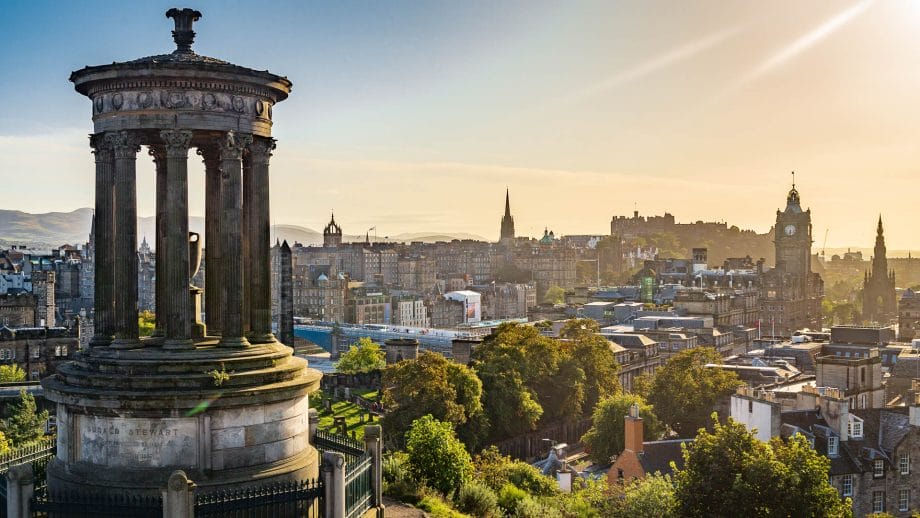
Info about Edinburgh:
” Sightseeing
” Shopping
” Festivals
” Best time to travel
” Accommodation
” Tram, bus & train
” Things to know
Edinburgh – whether you want to visit the Scottish capital for a few days at the beginning or end of a tour of Scotland or go on a city trip lasting several days, the many sights will amaze you. Edinburgh promises unforgettable experiences. I have written down here what you can expect there – I took all the photos myself and visited and experienced the sights myself.
Highlights: Edinburgh’s most important sights
The top ten sights in Edinburgh at a glance
Here are the ten must-sees for your first visit to Scotland’s capital. Each click on the link takes you to the bottom, where the attraction is described in more detail with a picture. However, it’s worth scrolling further down, as there are many more important sights to see.
👉 TIP: The admission prices listed here are approximate and, where possible, refer to the cheapest option. In the case of some attractions, this means that they must be purchased online the day before at the latest. It will be more expensive at the box office.
1 | Edinburgh Castle
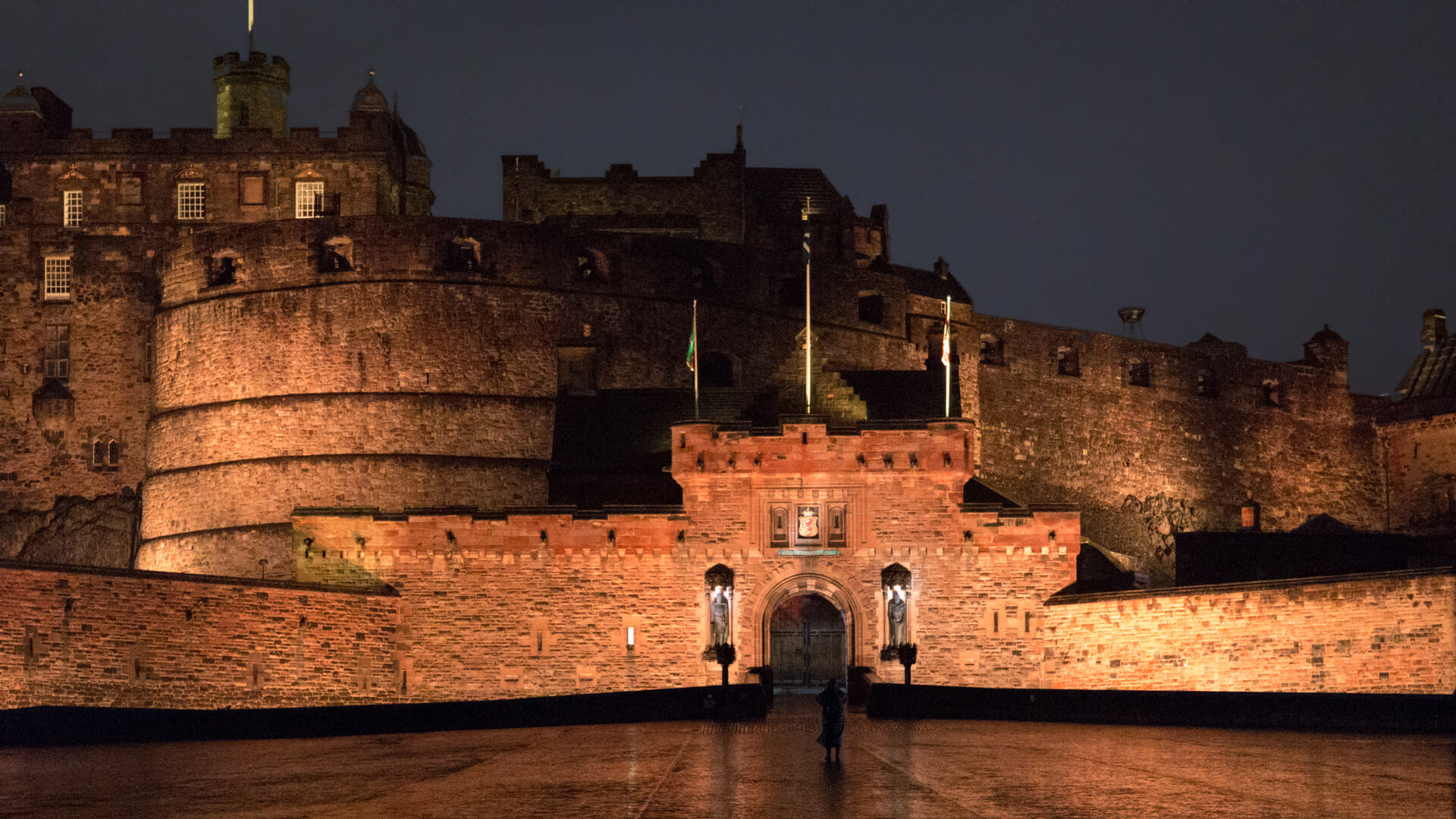
Of course THE building that towers above all others on Castle Hill in Edinburgh. Every August, the large square in front of the gate serves as the stage for the Military Tattoo, the large parade of military bands and dancers.
Visitors can enter the castle for around £20 – and it’s well worth it. On the one hand, they can enjoy a beautiful view of Princes Street Gardens and Edinburgh’s New Town from the walls, and on the other, they can gain an insight into the interior and the history of Edinburgh Castle and its former inhabitants.
A spectacle is the “one o’clock gun”, which is fired from the castle walls every day except Sundays. It once gave the sailors down in Leith harbour the exact time. The tradition is still carried on today with military precision.
👉 TIP: To avoid queuing, you can buy tickets online in advance. For example here (advert).
Opening hours:
Summer Apr-Sep: daily 09:30-18:00
Winter Oct-March: daily 09:30-17:00
Last admission one hour before closing
Tours at 10:30 and 14:30
Admission: approx. between £19.50 and £21.50 adults, approx. £13 children
Address: Castlehill, Edinburgh EH1 2NG
Web: www.edinburghcastle.scot
2 | Calton Hill
To the east, Princes Street leads to one of Edinburgh’s seven hills: Calton Hill. There are numerous monuments on its summit, such as the National Monument, the Nelson Monument and the Dugald Stewart Monument, which features in so many pictures. There is also an observatory on Calton Hill.
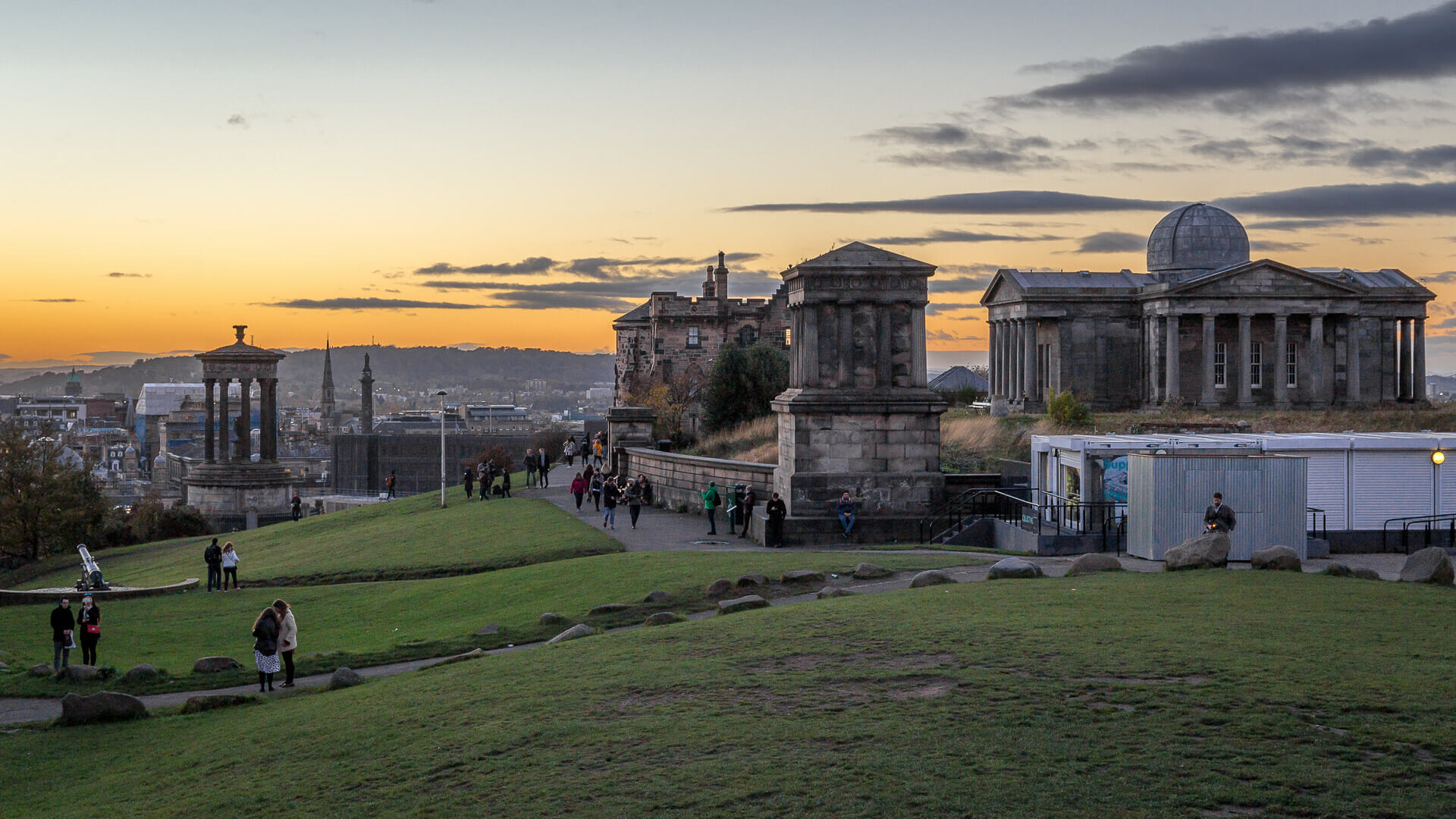
At sunset, people gather here and look westwards over the city. When the sky turns orange and the city lights slowly come on, Edinburgh shines with a glow all of its own.
More about Calton Hill here.
👉 TIP: At the foot of the hill, when you come to the extension of Princes Street, Waterloo Place, there is a hidden cemetery, Old Calton Burial Ground. If you like cemeteries, pay it a little visit.
Opening hours:
Hill always accessible
Opening hours Nelson Monument:
Currently closed due to construction work
Admission: free
Web: www.edinburghmuseums.org.uk/venue/nelson-monument
Address: Calton Hill, Edinburgh EH7 5AA
3 | Palace of Holyroodhouse
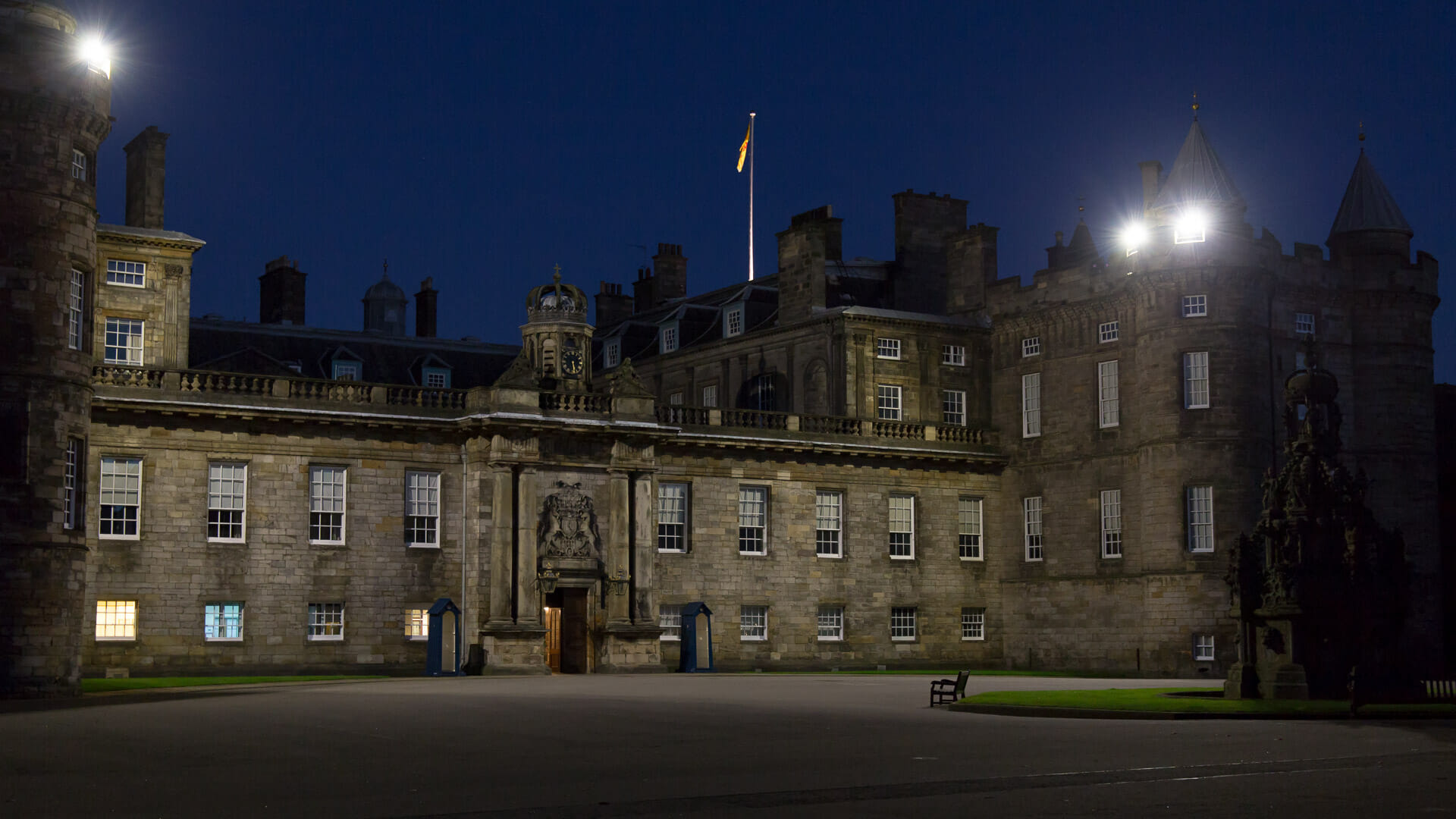
The Royal Mile now ends at the gates of the palace. Holyrood Palace was originally built as the guest house of an abbey, but over the centuries the Scottish and British kings expanded it into a stately castle.
Today, it is the official residence of the British royal family in Scotland, which the king – should he continue the tradition – moves into at least once a year.
Visitors can tour part of the palace, including the historic apartments of Mary, Queen of Scots. Behind the palace are the Salisbury Crags with the famous Arthur’s Seat.
👉 TIP: To avoid queuing, you can buy tickets online in advance. For example here (advert).
Opening hours:
Nov-Mar: 09:30-16:30
Apr-Oct: 09:30-18:00
Last admission one hour and 15 minutes before closing time
Thu 15 May – Sat 24 May 2025 – Castle closed
Thu 26 June – Fri 04 July 2025 – castle & café closed
Admission: approx. 21 pounds adults, approx. 13.50 pounds children
Address: Canongate, Edinburgh EH8 8DX
Web: www.rct.uk/visit/palace-of-holyroodhouse
4 | Princes Street Gardens
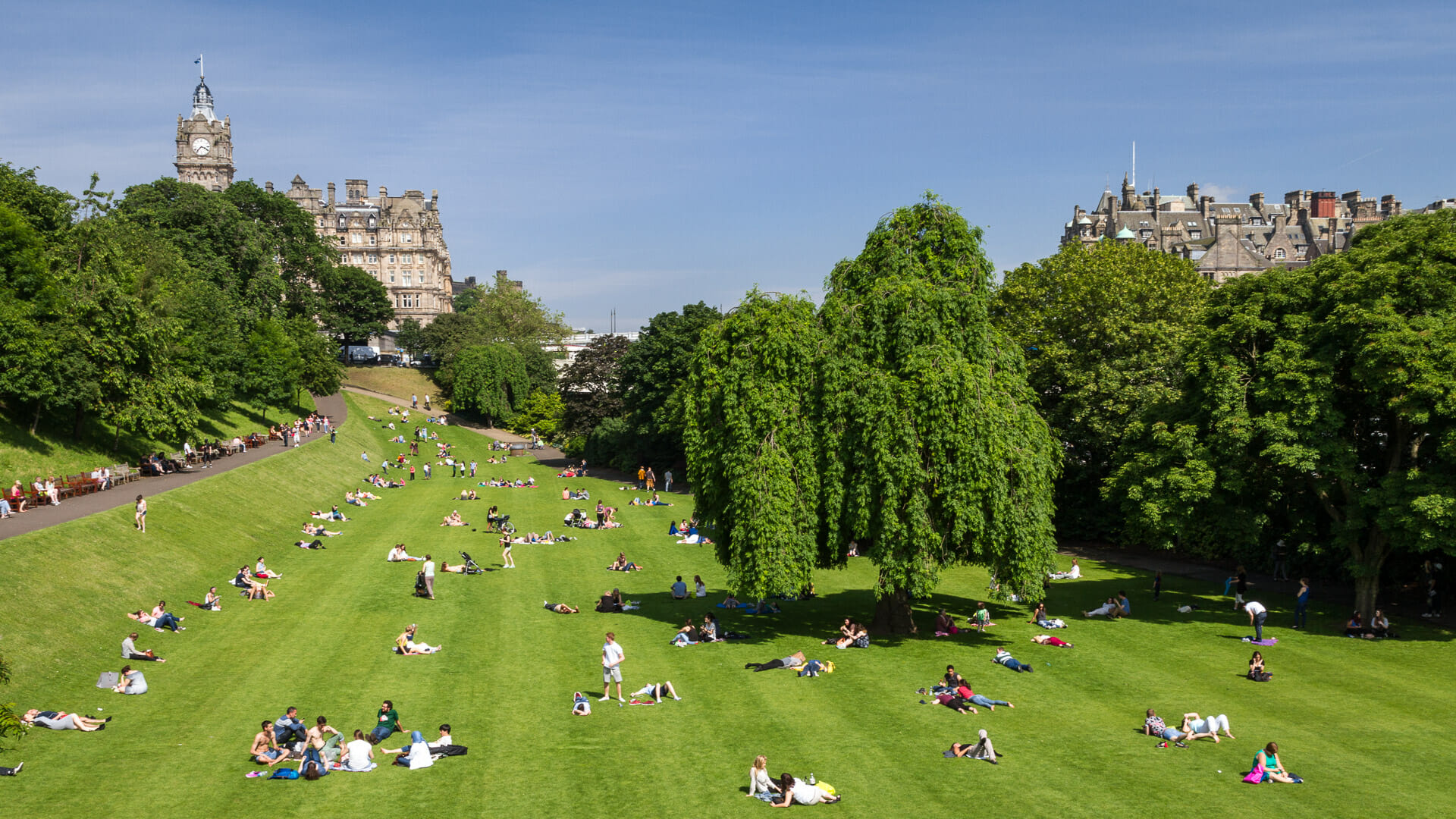
Opposite the shops, between Princes Street and Castle Hill, are the Princes Street Gardens – a long, green park where Edinburgh residents relax on park benches and green spaces in the sunshine.
At the junction with The Mound, gardeners have been planting up to 30,000 plants in the Floral Clock every summer since 1903. The small Gardener’s Cottage is also worth a visit.
Opening times:
daily 07:00 opening, depending on the season the park closes in the evening from 17:00, in summer until 21:00 approx
Admission: free
Address: Princes St, Edinburgh EH2 2HG
Web: www.edinburgh.gov.uk/directory-record/1208325/princes-street-gardens
5 | Greyfriar’s Bobby & Kirkyard
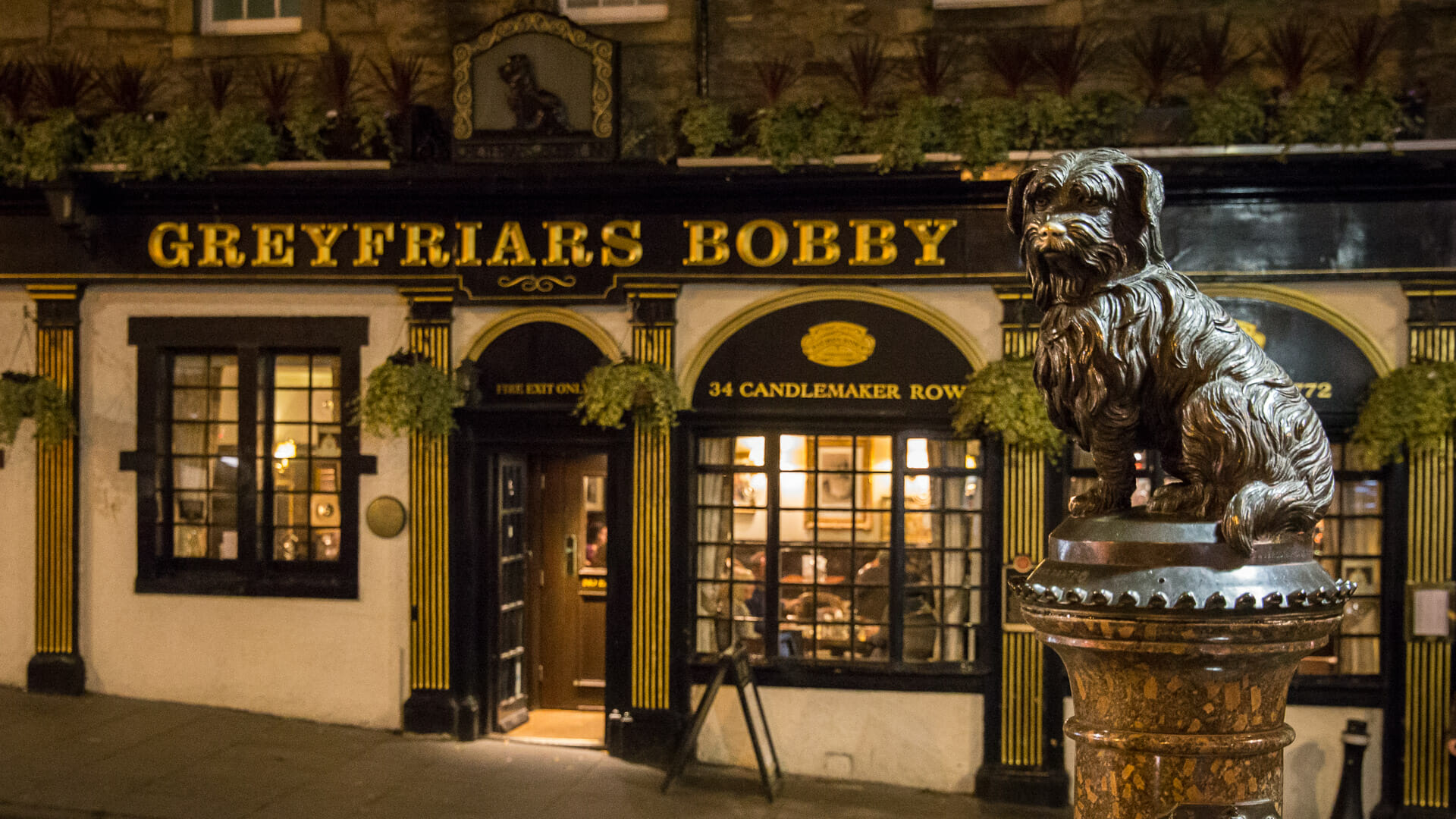
Probably the most famous dog in Scotland was the Greyfriar’s Bobby. The story goes like this: A man’s dog sat at his owner’s grave in Greyfriar’s Cemetery for years after his death. Then one day he died himself. But a bronze statue was erected in his memory. The pub behind it has taken his name. Even if historians are now putting the dog’s story into perspective, the legend itself is simply too beautiful.
❗️Note: Please don’t rub the dog’s nose. Incidentally, the cemetery is just down the road from the pub towards the Castle.
More information about Greyfriars Kirkyard and Bobby here.
Opening hours:
Always
Address: Edinburgh EH1 2QQ
6 | St Giles’ Cathedral
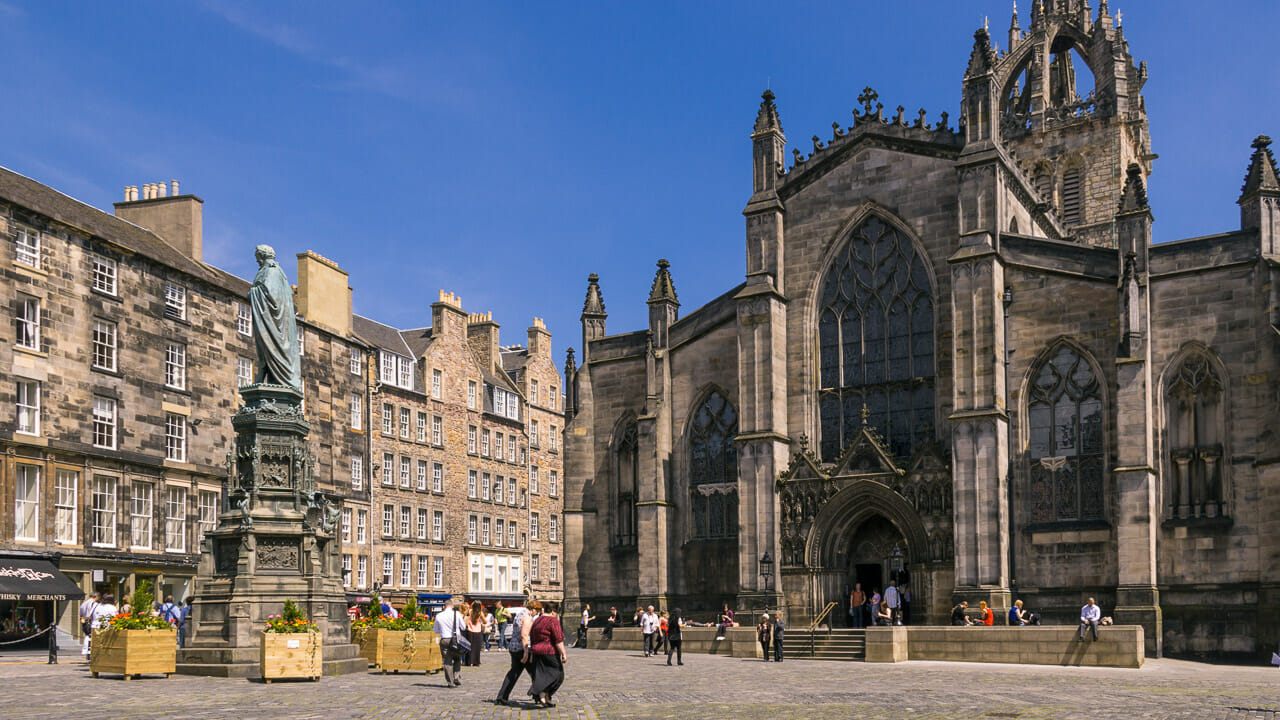
After the first major crossroads crosses the Royal Mile, you reach a square with a cathedral – this is St Giles’ Cathedral. A small church stood here around 900 years ago, but it was not until the 14th century that it was extended in the Gothic style.
Inside you can see rooms and buildings from different eras. The Thistle Chapel, a small chapel at the end of the cathedral, is very beautiful. The interior is decorated with elaborate carvings.
Detailed information about St Giles’ Cathedral can be found here.
Opening hours:
Mon-Fri: 10:00-18:00
Sat: 09:00-17:00
Sun: 13:00-17:00
Admission: free
Address: High St, Edinburgh EH1 1RE
Web: stgilescathedral.org.uk
7 | Royal Yacht Britannia
The Royal Yacht Britannia is anchored here. The luxury ship once sailed the royals around the world. however, it was decommissioned in 1997 and is now permanently moored directly behind a large shopping centre. Today, Queen Elizabeth II’s yacht can be viewed from here, which is highly recommended. Detailed information in the article on the Royal Yacht Britannia.
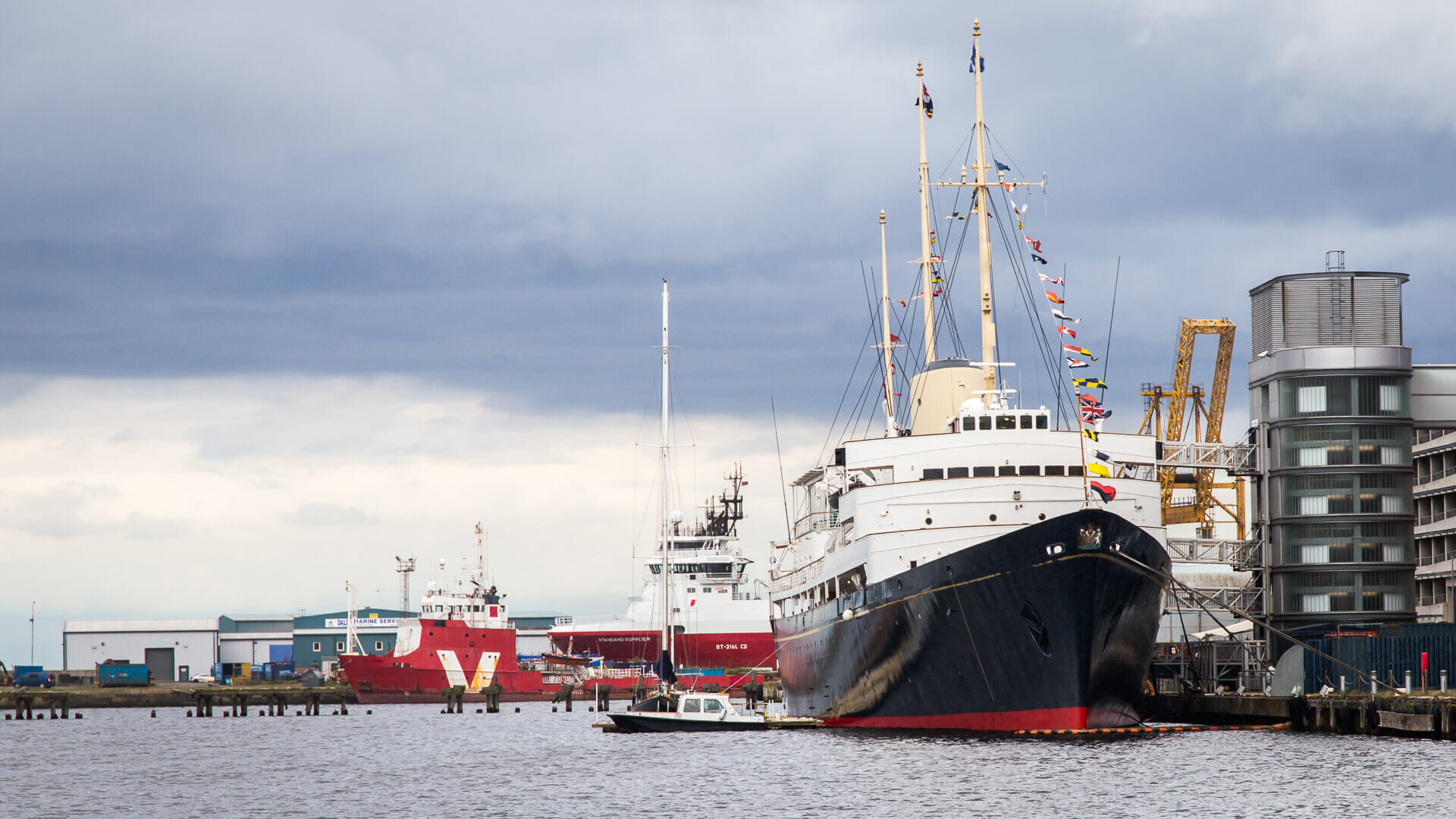
Incidentally, I saw the Britannia in action in the mid-1990s. The picture was taken in Thurso and is scanned from a slide.
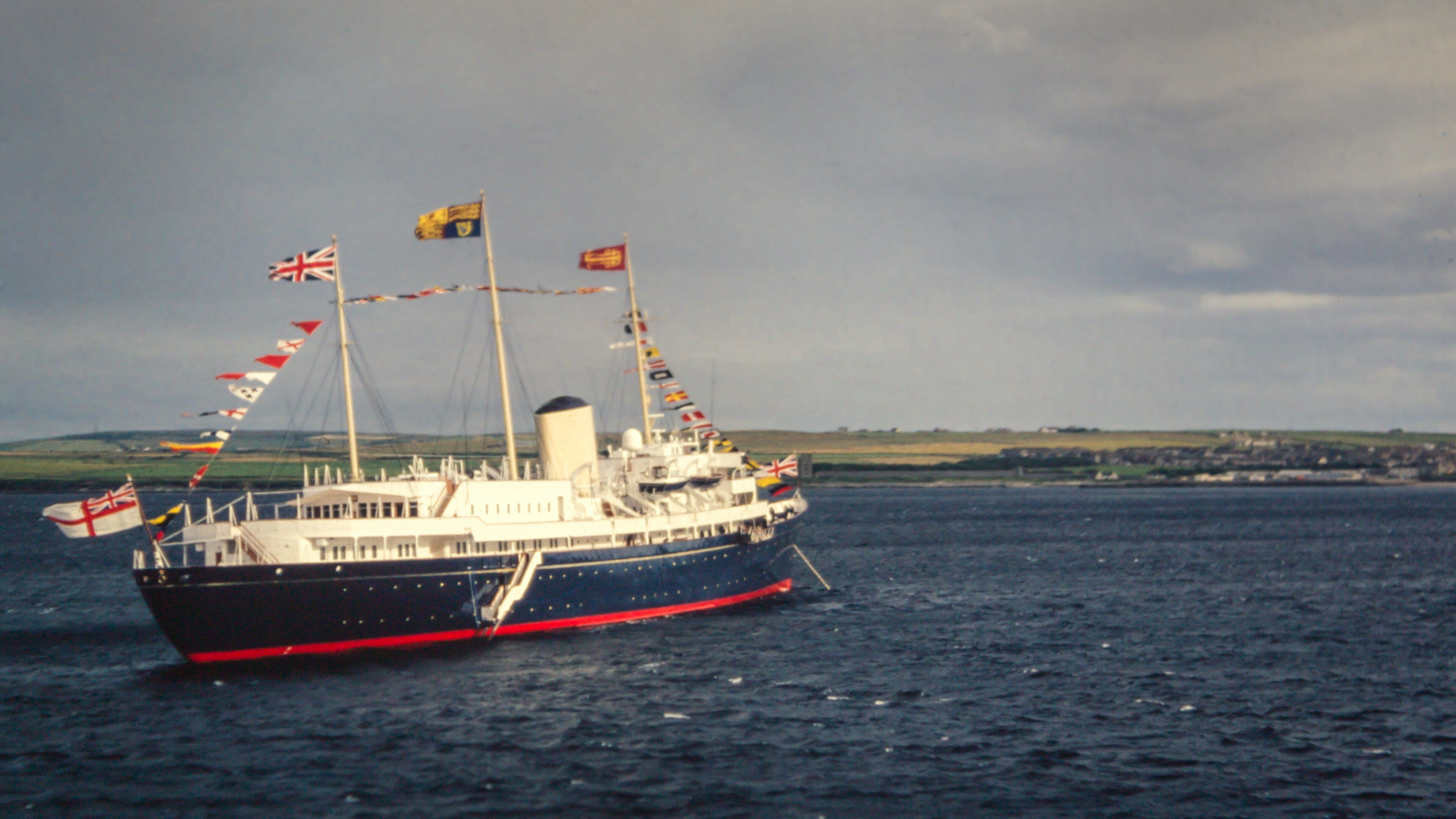
👉 TIP: To avoid queuing, you can buy your tickets online.
Opening hours:
Nov-Mar: 10:00-17:00
Apr-Aug: 09:30-18:00
Sep: 09:30-18:00
Oct 09:30-17:30
Last admission 2 hours before closing time
Admission: Adults approx. 20 pounds, children approx. 9.50 pounds
Address: Ocean Drive, Leith, Edinburgh EH6 6JJ
Web: www.royalyachtbritannia.co.uk
8 | National Museum of Scotland
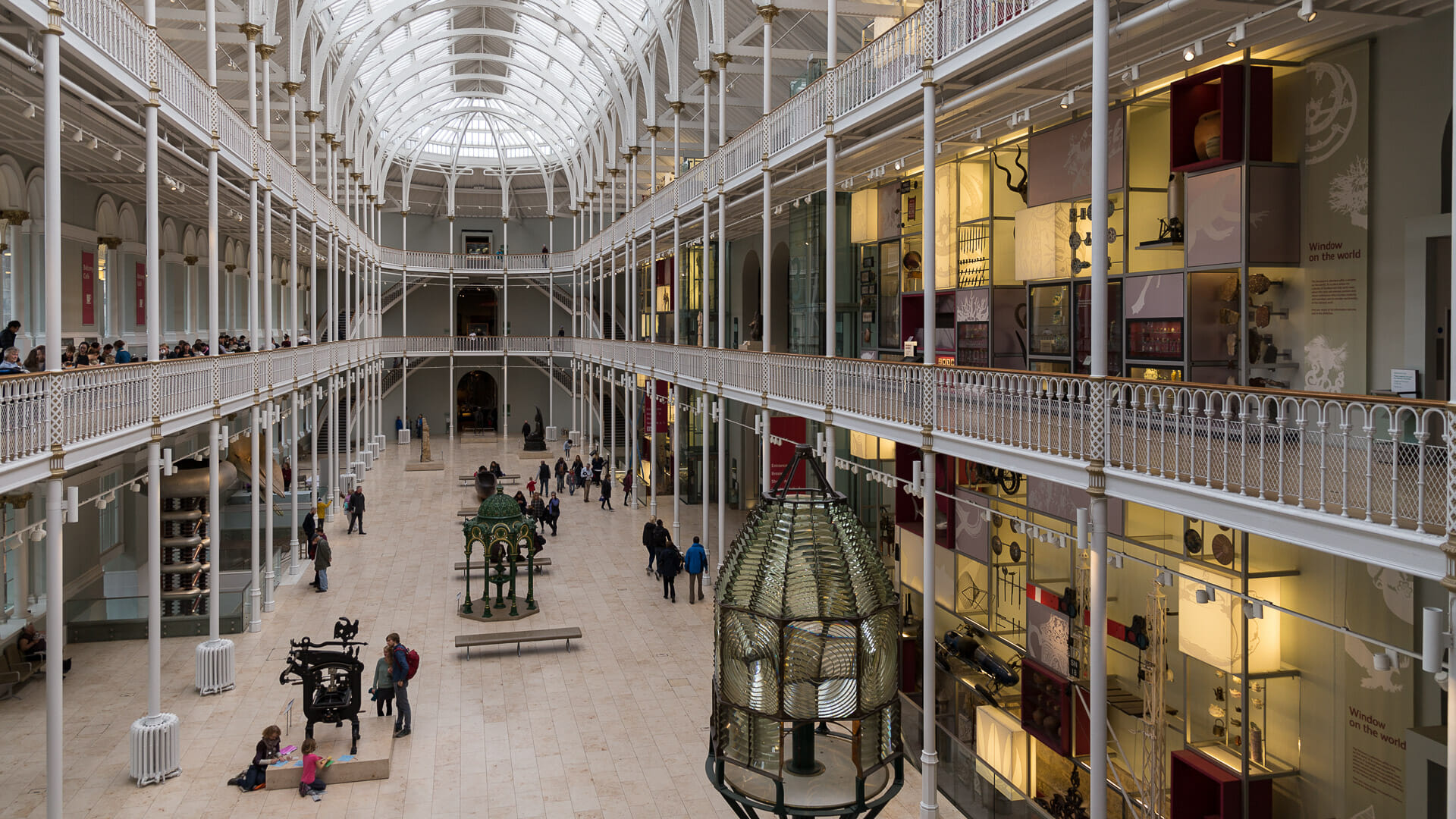
The National Museum is a real alternative, especially when it’s raining. Wonderful exhibits from the entire history of Scotland can be seen here. A few highlights: Dolly, the cloned sheep; the Lewis Chessmen; the history of Scotland with many artefacts; furniture, clothing and design from the last few centuries and, of course, the beautiful Victorian entrance hall.
As with many museums in Scotland, admission to the National Museum is free. All that is asked is a donation – which enthusiastic visitors are happy to give.
More information here.
Opening hours
daily 10:00-17:00
Admission: free
Address: Chambers Street, Edinburgh, EH1 1JF
Web: www.nms.ac.uk/national-museum-of-scotland/
9 | Mary King’s Close
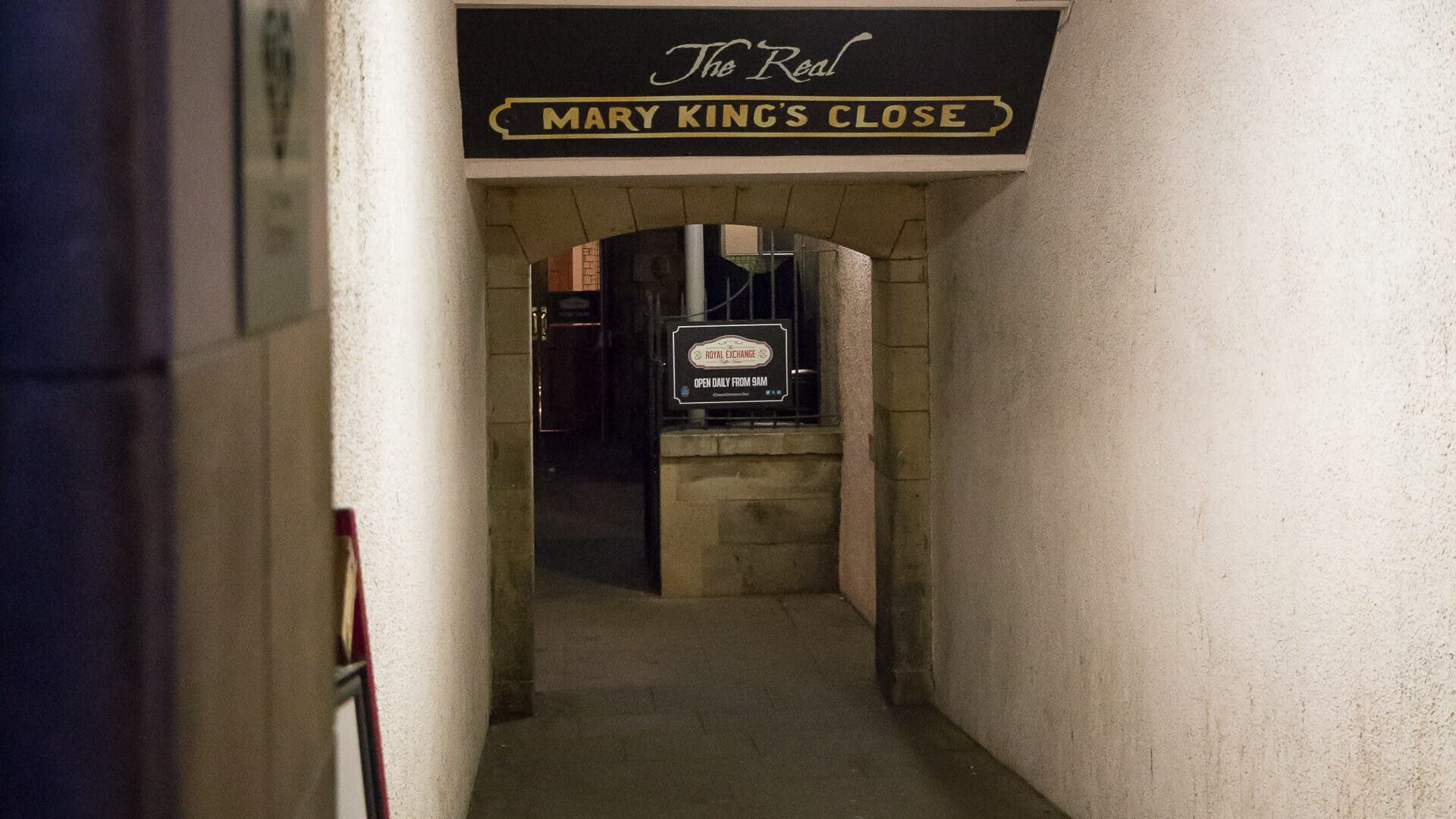
Closes lead off to the left and right of the Royal Mile. These are narrow alleyways that lead down the hill, often already built over by houses. Mary King’s Close was walled in in such a way that over time it went underground.
Today it is a tourist attraction. The guides talk about historical findings as well as the haunting phenomena that surround the place.
👉 You can pre-book tickets online. For example here (advert).
Opening hours:
weekends: 10:00-18:30, May and June also during the week
Admission:
Adult approx. 21 pounds, child approx. 15 pounds
Address: Warriston’s Close, 2, High St, Edinburgh EH1 1PG
BOOK ONLINE IN ADVANCE!
Web: www.realmarykingsclose.com
10 | Arthur’s Seat
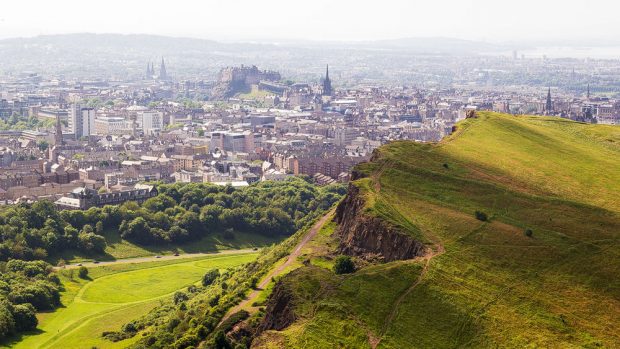
Which capital city has its own mountain right in the centre? Edinburgh! Arthur’s Seat, part of the Salisbury Crags, rises directly behind Holyrood Palace. So if you’re fed up with the city centre, climb up the mountain – either directly or via a diversion along the Crags. There are great views over Scotland’s capital from everywhere. But be careful: if you want to get to the top, you’ll have a bit of a scramble at the end. Sturdy shoes are recommended.
More about Arthur’s Seat here.
Opening hours:
always open
Admission: free
Address: Arthur’s Seat, Edinburgh EH16 5HX
Discover more sights in Edinburgh – what you need to know
Edinburgh is roughly divided into two areas: There is the old city, which stretches along the ridge of Castle Hill down to the foot of Salisbury Crags. The Royal Mile is the backbone of this old city, with streets or so-called closes – narrow alleyways and enclosed passageways – running off to the side. Everything seems to have grown quite organically here.
The second part is the New Town. It lies opposite the Old Town, separated by Princes Street Gardens. Geometric streets dominate here. The neo-classical buildings with their magnificent columns have earned Edinburgh the name “Athens of the North”. The crowning glory of this new district is Calton Hill with its monuments.
Both areas of the city are worth a visit. The Royal Mile and the surrounding area are worth a day or two – depending on your shopping appetite. The New Town can also be explored in about a day. In addition, there are other more remote and very interesting neighbourhoods in Edinburgh, all of which are mentioned below.
By the way: One way to discover the Old Town at night is on a guided tour with a creepy factor. They usually start at Mercat Cross near St Giles Cathedral, where you can also pick up flyers during the day and ask for prices.
Map: Edinburgh’s sights
Where is what? The map shows you. And then there are more sights in detail.
You are currently viewing a placeholder content from Google Maps. To access the actual content, click the button below. Please note that doing so will share data with third-party providers.
More InformationOld Town: Royal Mile, Castle, Shopping
Royal Mile
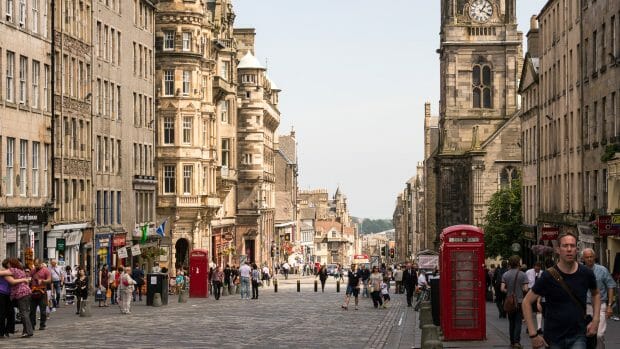
The Royal Mile runs from the Castle in the west down to Holyrood Palace in the east and actually covers a mile, or about 1.5 kilometres. It not only connects the castle and the palace, but was once the backbone of medieval Edinburgh. That is why there are still a number of interesting sights along its route today – and of course many shops. You can reserve a whole day just for them, including a shopping spree and dinner.
Here is an overview of the most important and most beautiful sights along the Royal Mile, lined up from west to east:
The Scotch Whisky Experience
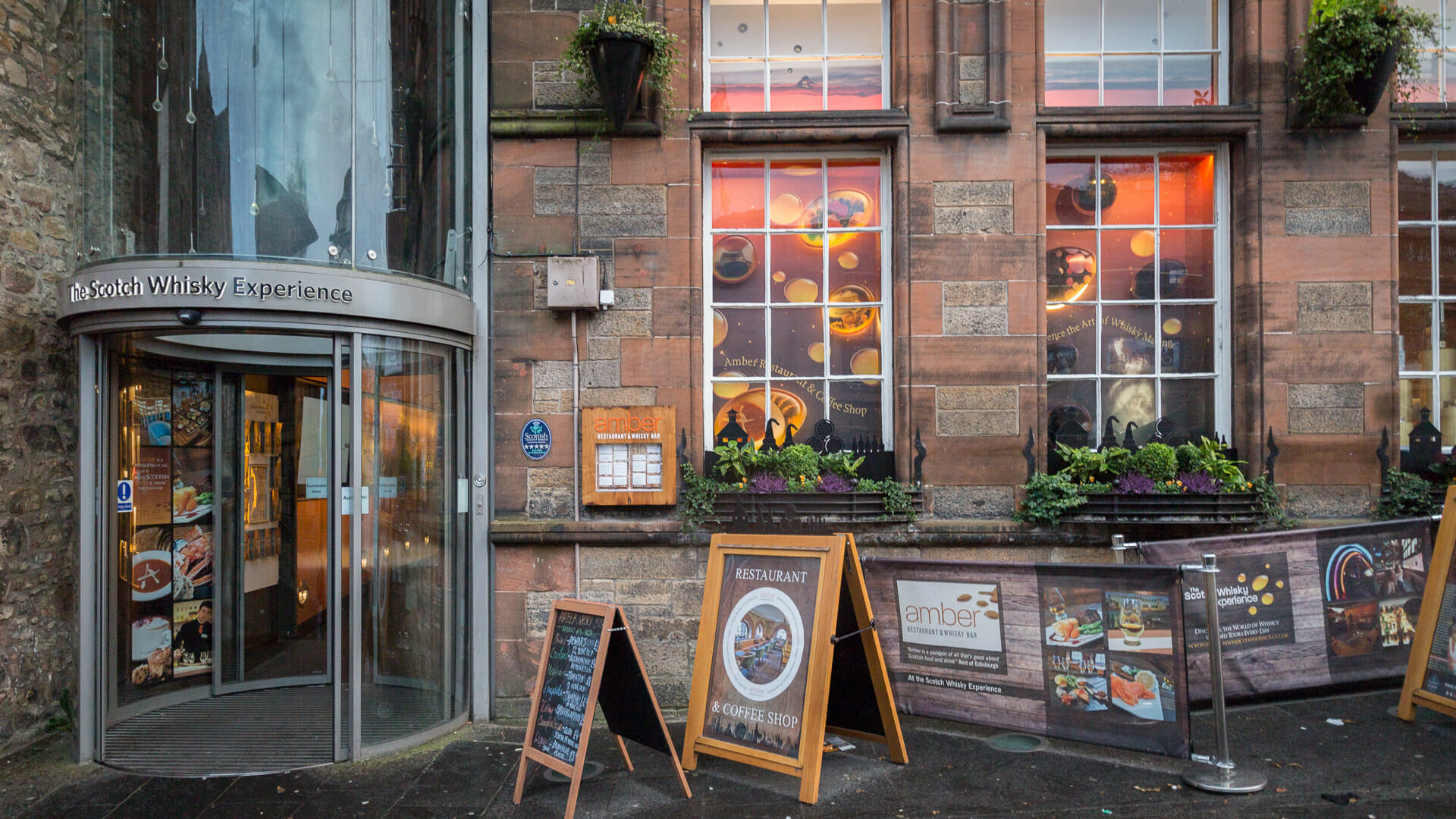
Have you ever ridden a ghost train in a wooden barrel? You can at the Scotch Whisky Experience. And you don’t even need to be afraid of the ghosts here. During the ride in the barrel, the ghost tells you how the “water of life” – Scotch whisky – is made.
After the ride, you can enjoy a dram of whisky and take a look at the largest whisky collection in the world. The exit is directly in the adjoining shop with many types of whisky.
The visit is fun. However, you can save yourself the trouble if you plan to visit a distillery on holiday before or after. This is because in every distillery you can learn something about the production process and usually also get a tasting sip.
👉 You can book the experience here. (advert link)
Opening hours:
daily 10:00-18:00
Admission: Tours from £21 upwards depending on whisky tastings
Address: The Royal Mile, 354 Castlehill, Edinburgh EH1 2NE
Web: www.scotchwhiskyexperience.co.uk
Camera Obscura
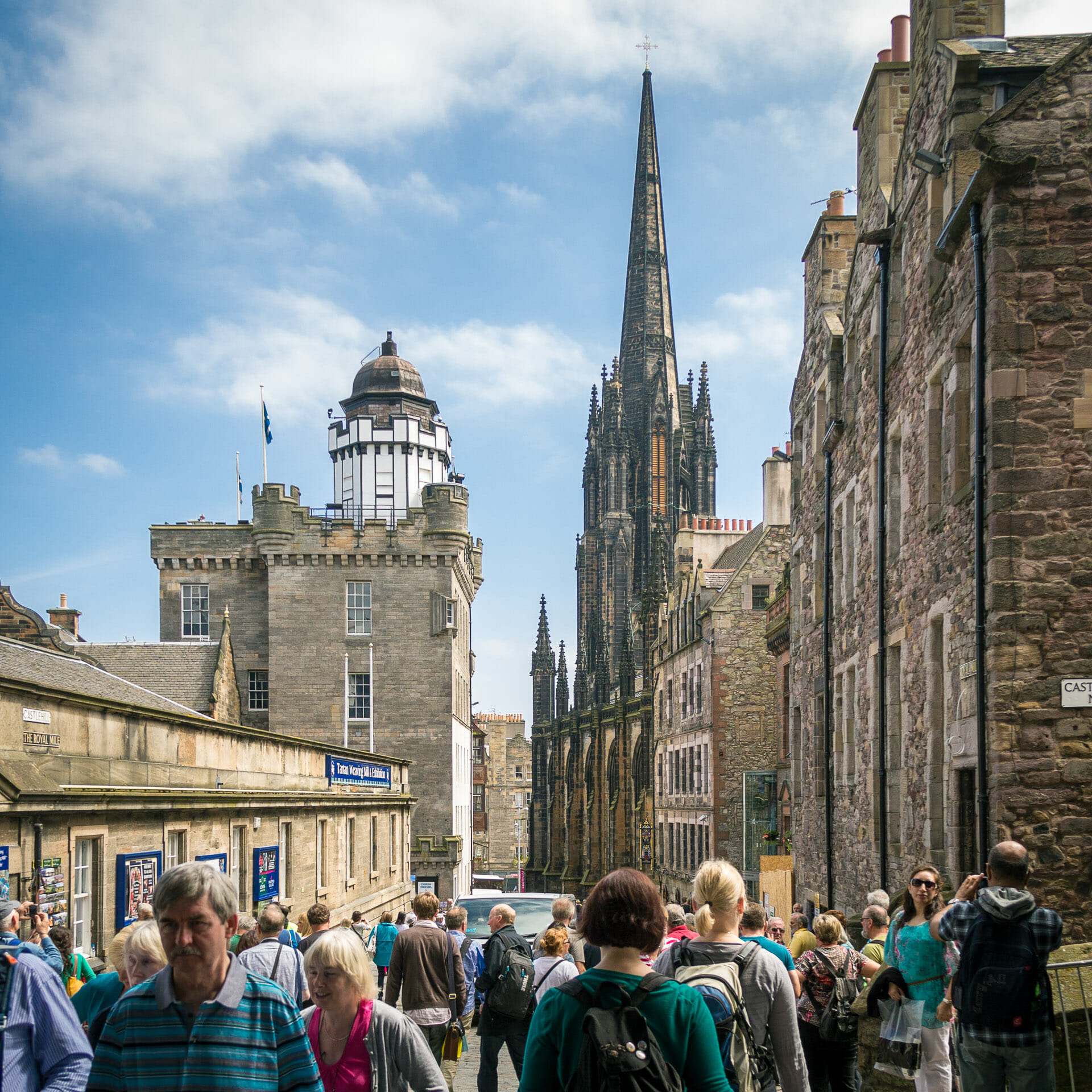
Directly opposite the Whisky Experience is the building with the “Camera Obscura” and the “World of Illusion”. Here visitors will find optical illusions, have a view over Edinburgh from the roof and can see how the old camera obscura in the tower of the building projects an image of the city onto a table.
Opening times:
daily, opens at 09:00 or 09:30, closes between 20:00 and 22:00
Admission: adult approx. 24 pounds, child approx. 18 pounds
Address: Castlehill, Royal Mile, Edinburgh EH1 2ND
Web: www.camera-obscura.co.uk
The Hub
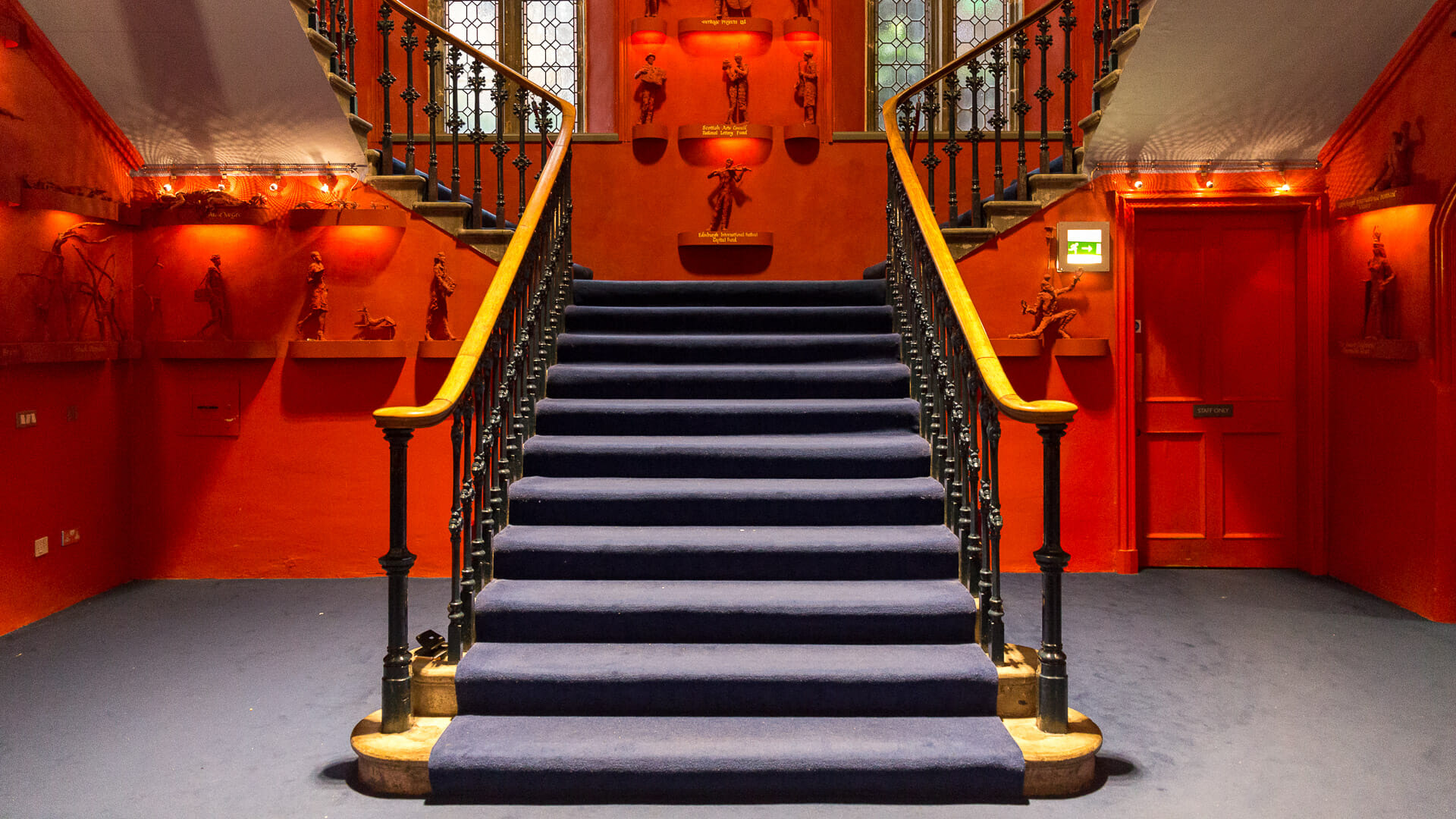
At the junction of Johnston Terrace and the Royal Mile stands a large church – at least it looks like a church, as the building was never actually consecrated. It was home to the General Assembly of the Church of Scotland in the mid-19th century. From the 1980s, however, the building stood empty until it was converted into “The Hub” in 1999.
Today, it hosts the annual International Festival in August, where artists from the fields of opera, dance and theatre meet and give performances. Outside of this time, conferences, weddings and other events take place.
There is also a café inside.
John Knox House
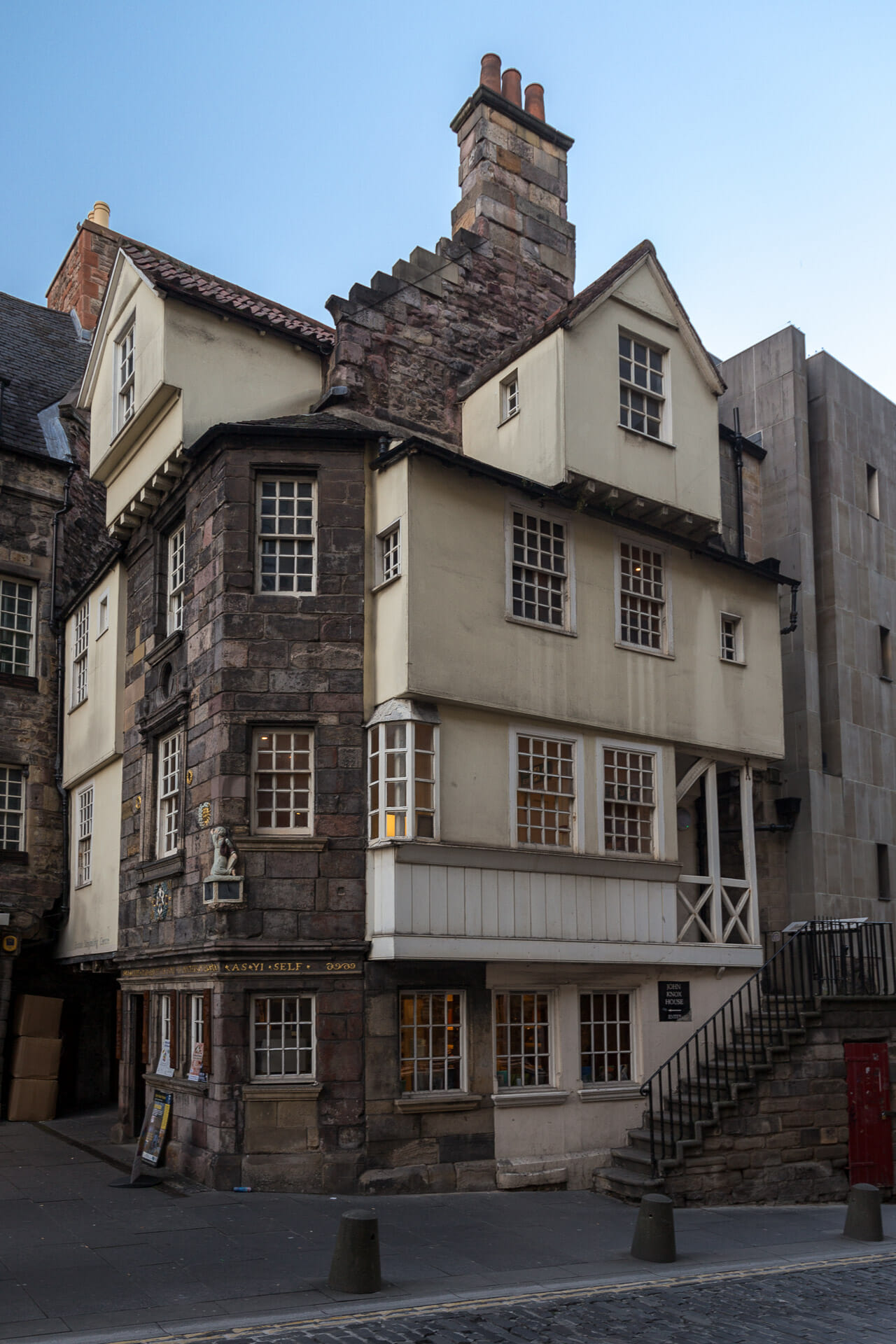
A little further down the Royal Mile, the road narrows at a house with lime-white bay windows. This is John Knox House. John Knox was the Martin Luther of the Scots, so to speak, a reformer of the church.
The house is one of the few buildings that still has the typical appearance of the Middle Ages. It is said to have been built around 1470. One famous and long-time resident was James Mosman, the jeweller and goldsmith to Mary, Queen of Scots. He lived here for around twenty years before he was executed in 1573 as a loyal supporter of the Queen.
John Knox himself only lived here for a very short time, presumably in 1572, but that was enough to save the house from demolition. Fortunately for today’s visitors, they can see old rooms with many small historical details inside.
Opening times:
daily Mon-Sun, 10:00-18:00, last admission 17:00
Admission: adult approx. 7 pounds, child approx. 1.50 pounds
Address: Scottish Storytelling Centre, High St, Edinburgh EH1 1SR
Web: www.scottishstorytellingcentre.com/john-knox-house/
Canongate Tolbooth
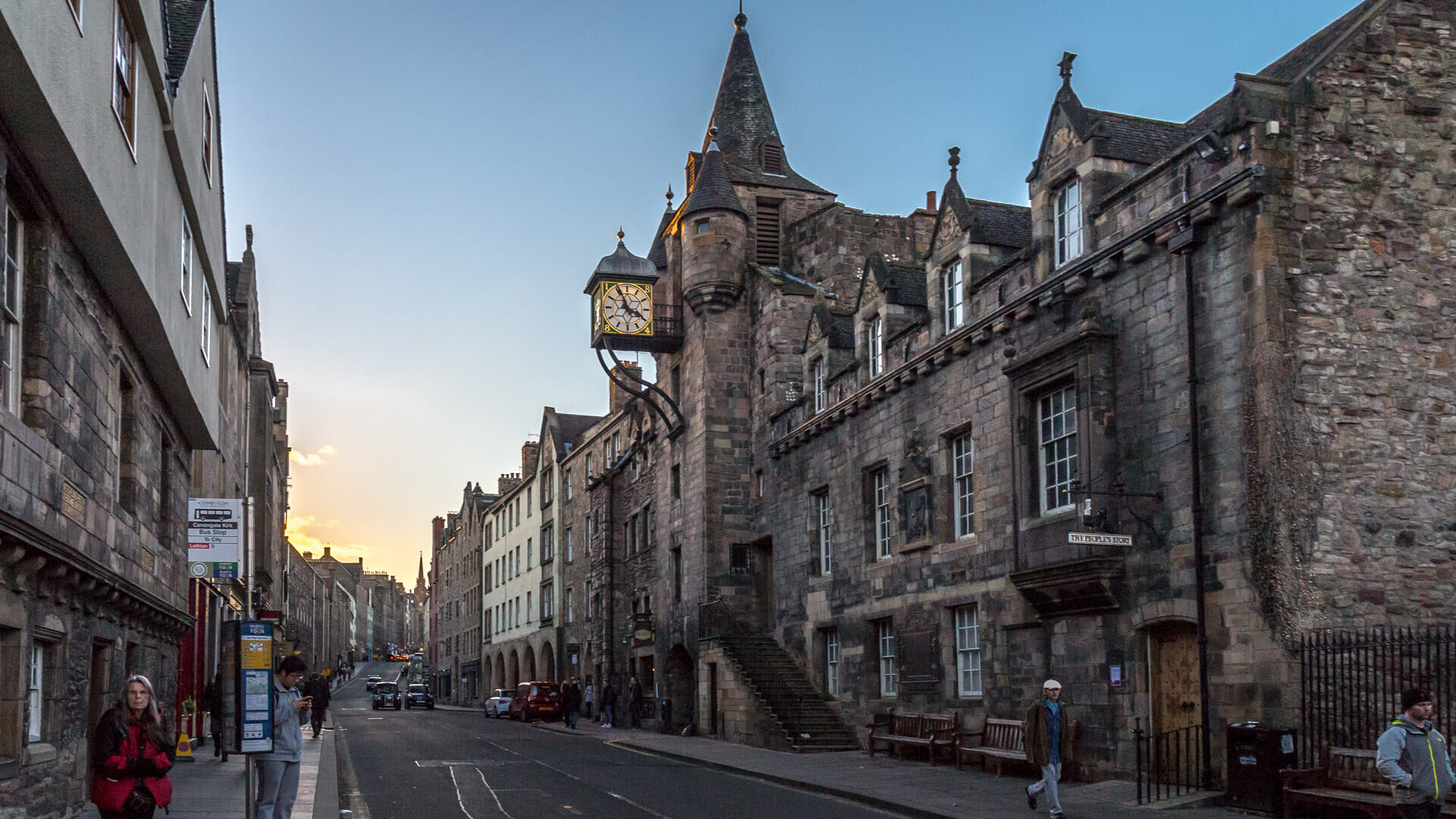
Just behind John Knox House, a beautiful old clock protrudes from the tower on a building. From the 16th century, it served as a courthouse, prison and meeting place for the old Canongate neighbourhood, which once lay outside Edinburgh’s city walls.
Today it houses“The People’s Story Museum“, which shows the lives of ordinary people in Edinburgh from the 18th century onwards.
Opening times:
daily 10:00-17:00, last admission half an hour before closing time
Admission: –
Address: The Royal Mile, 163 Canongate, Edinburgh EH8 8BN
Web: www.edinburghmuseums.org.uk/venue/peoples-story-museum
Kirk of Canongate
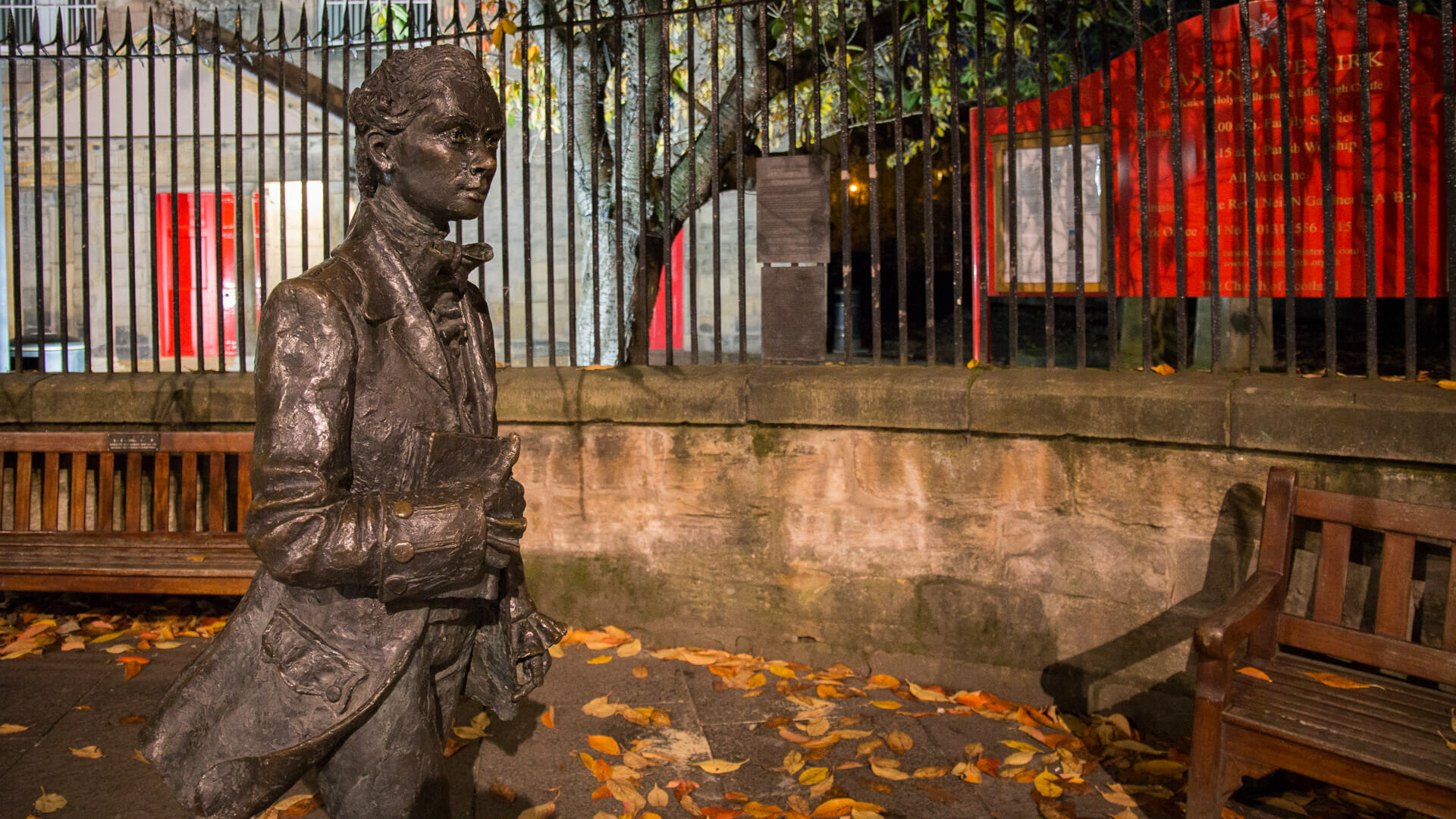
It may seem to be just a side attraction: the Kirk of Canongate with the youthful statue in front of it. However, it does function as a parish church, whose grounds also include Holyrood Palace, the Scottish Parliament and even the distant Edinburgh Castle. So it’s no wonder that Queen Elizabeth II’s granddaughter got married in it in 2011.
It was built at the end of the 17th century at the behest of James VII. Several famous people have found their final resting place inside. For example Adam Smith, the famous economist, or the poet Robert Fergusson, who can be seen as a bronze statue in front of the church gate.
Opening hours:
As long as the door is open
Admission: –
Address: 153 Canongate, Edinburgh EH8 8BN
Web: www.canongatekirk.org.uk
White Horse Close
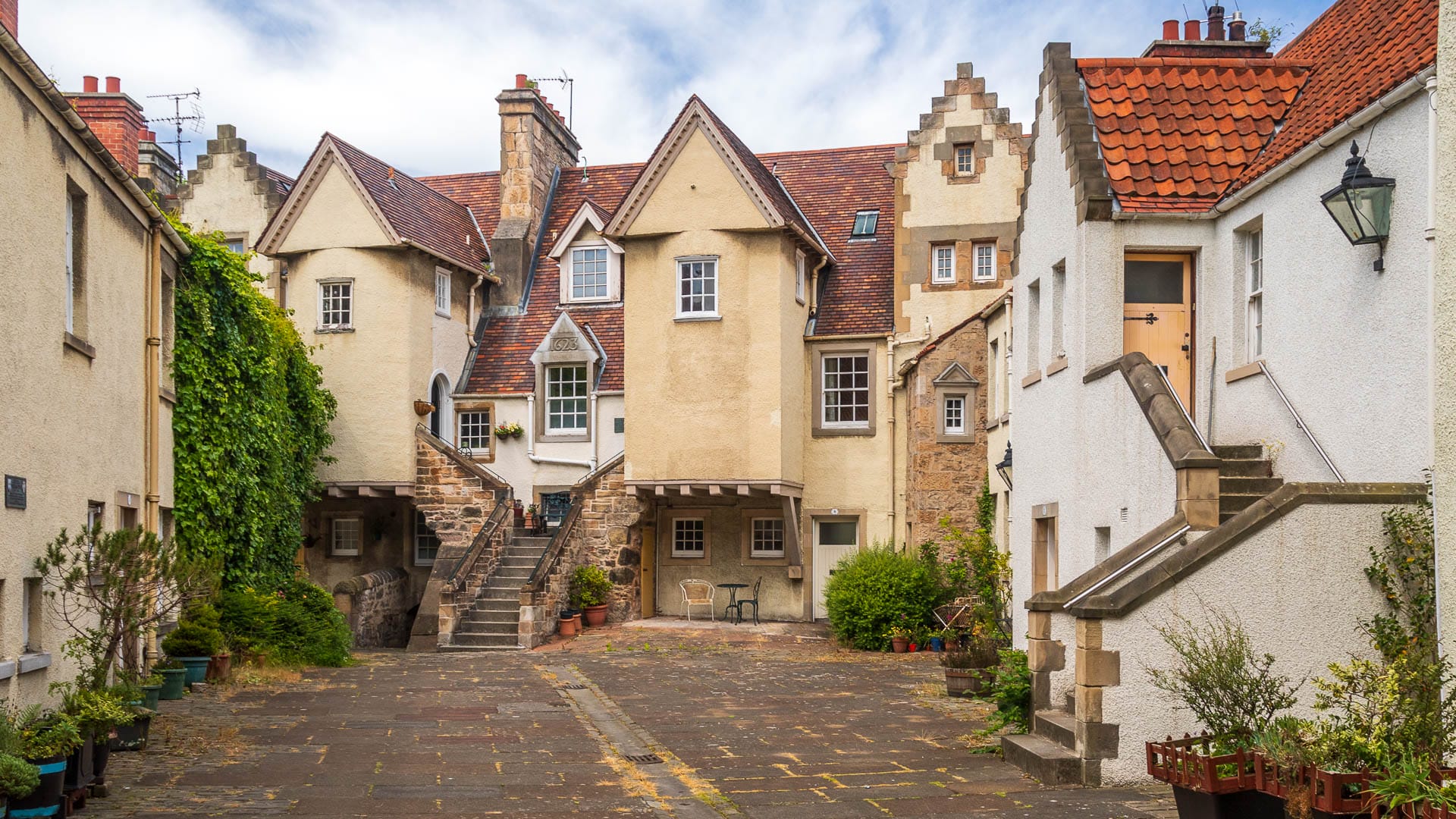
Attention: Many people overlook this sight. An inconspicuous house entrance under a rather modern-looking building takes you back around 300 years into the past after just a few steps. This is because the White Horse Close with its old white houses is located in the backyard. Today, it is a welcome and somewhat quieter detour from the Royal Mile. It is also a wonderful photo opportunity and has a special atmosphere, especially in the evening.
Opening hours:
always accessible
Admission: –
Address: 10 White Horse Cl, Edinburgh, United Kingdom
Scottish Parliament Building
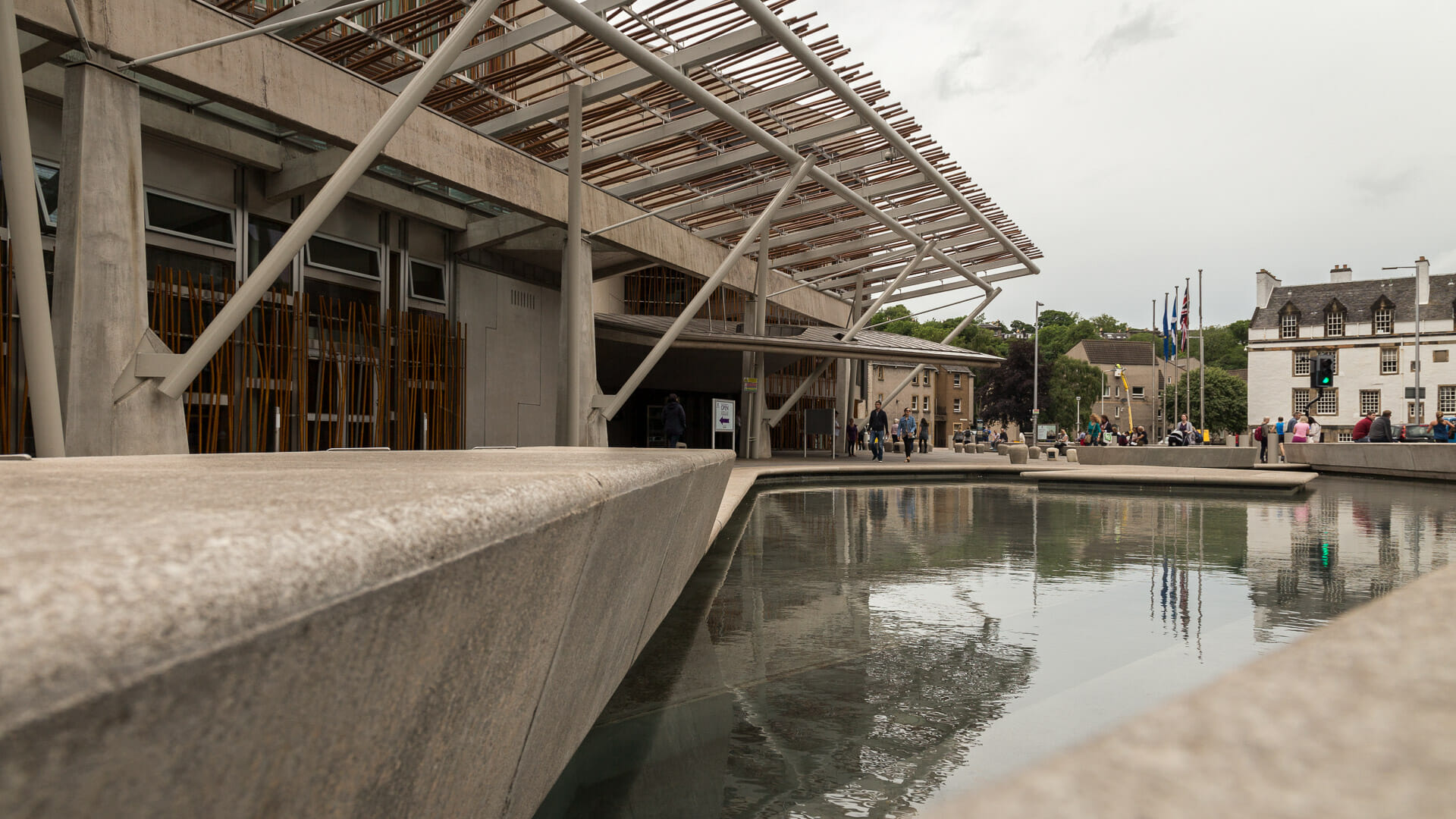
After all the medieval architecture, the modern Scottish Parliament building stands out conspicuously. In fact, in recent years and decades, many administrative tasks have been relocated back to Scotland from faraway London. This meant that the Scottish representatives needed a large assembly building. Designed by Catalan architect Enric Miralles, construction work began in 1999 and five years later it was inaugurated by Queen Elizabeth II. It is located just across the road from the Queen’s residence in Edinburgh, Holyrood Palace.
Opening hours:
Mon , Fri, Sat: 10:00 – 17:00,
Tue , Wed, Thu: 09:00 – 18:30,
but varies depending on the sessions
Admission: –
Address: Edinburgh EH99 1SP
Web: www.parliament.scot
New Town: Princes Street, George Street and Calton Hill
Running parallel to the Royal Mile in the newer part of Edinburgh is Princes Street with its hectic traffic and many clothes shops. The new tram also runs through here. A little further on is the upmarket George Street with more shops. And in between is the food mile of Rose Street.
But apart from the shopping, there are also some sights to see here.
Johnnie Walker Princes Street
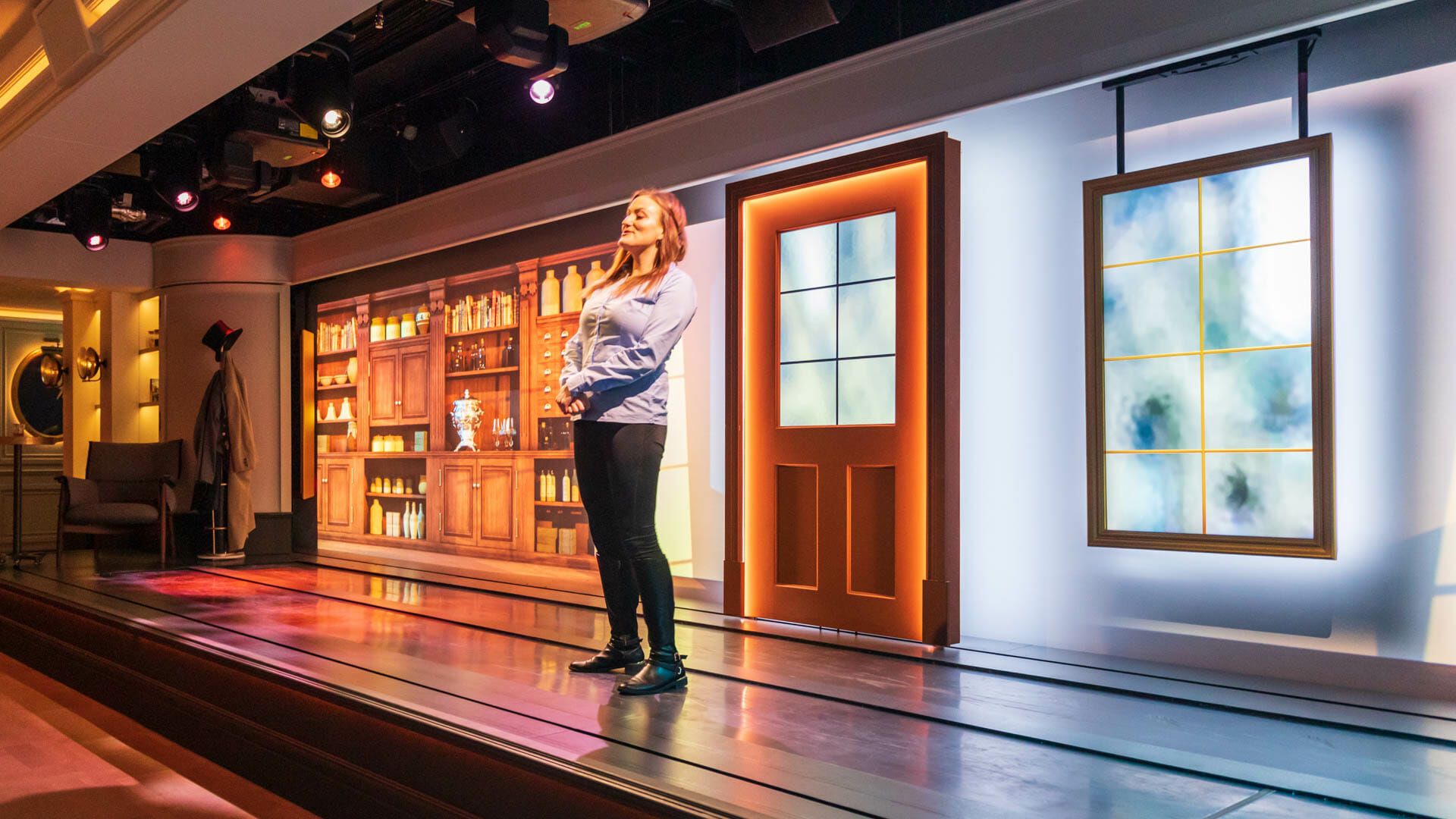
The Johnnie Walker Experience on Princes Street is set to open in summer 2021. Operator Diageo has completely transformed an old department stores’ building in the Art Deco style. There are several bars offering whisky and cocktails – each with a view of the old town opposite or even towards the sea. The Explorers’ Bothy offers rare bottlings to whisky connoisseurs. Tours also take visitors to the Sensory Tasting Room, where they can discover the different flavours of whisky.
A visit to Johnny Walker Princes Street is described here.
Opening hours:
Mon-Fri 11:00-21:00
Sat 10:00- 21.30
Sun 11:00-20:30
Admission: £30 for a one-way tour
Address: 145 Princes St, Edinburgh EH2 4BL
Web: www.johnniewalker.com/en/visit-us-princes-street/
National Galleries of Scotland
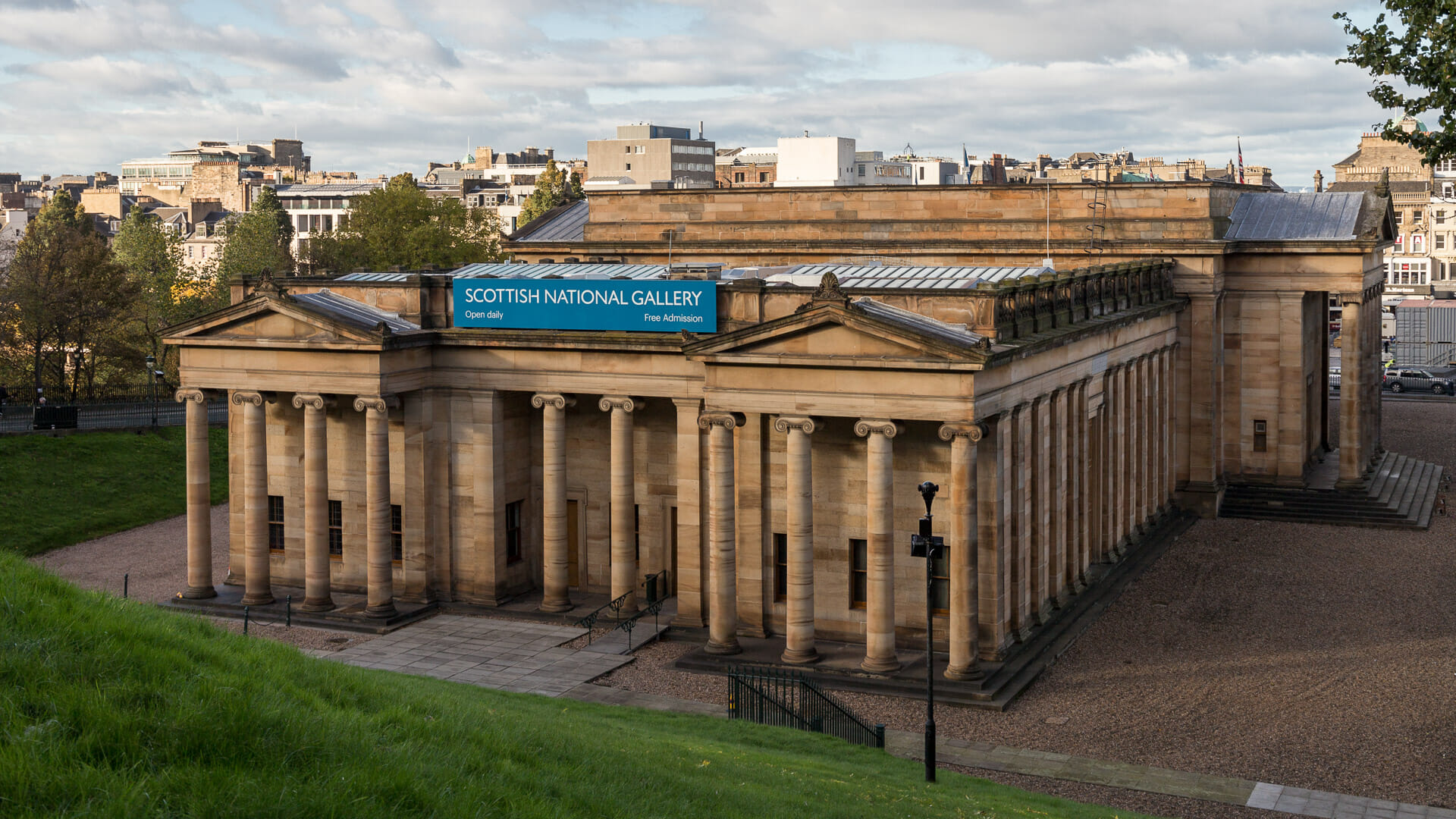
Under the motto “Art for Everyone”, the Scottish National Gallery exhibits works from different eras. These include artists such as Pablo Picasso, Paul Gauguin and Roy Lichtenstein.
Admission is free.
Opening hours
daily 10:00-17:00
Admission: free
Address: The Mound, Edinburgh, EH2 2EL
Web: www.nationalgalleries.org
Scott Monument
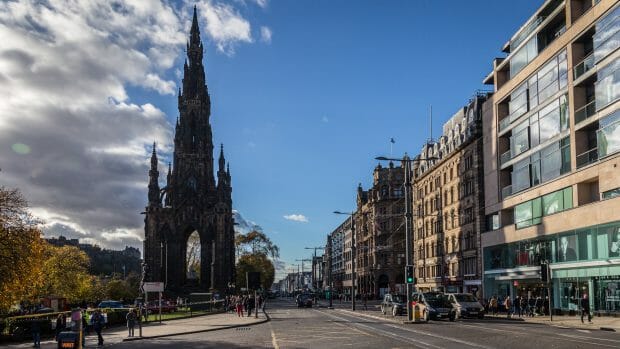
The Scots are proud of this author: Sir Walter Scott. That’s why they built the largest monument ever erected to a writer in the world in 1846. the Victorian tower is 61 metres high. Visitors can climb up to the viewing platform for a fee, but only a certain number of people per hour are allowed up to the top.
Opening times:
daily 10:00 -12:30 & 13:45 – 15:30
Last tour 15:30
Admission:
Adults: £8
Concessions & children: £6
Families: £20
Address: E. Princes St Gardens, Edinburgh EH2 2EJ
Web: www.edinburghmuseums.org.uk/venue/scott-monument
Balmoral Hotel
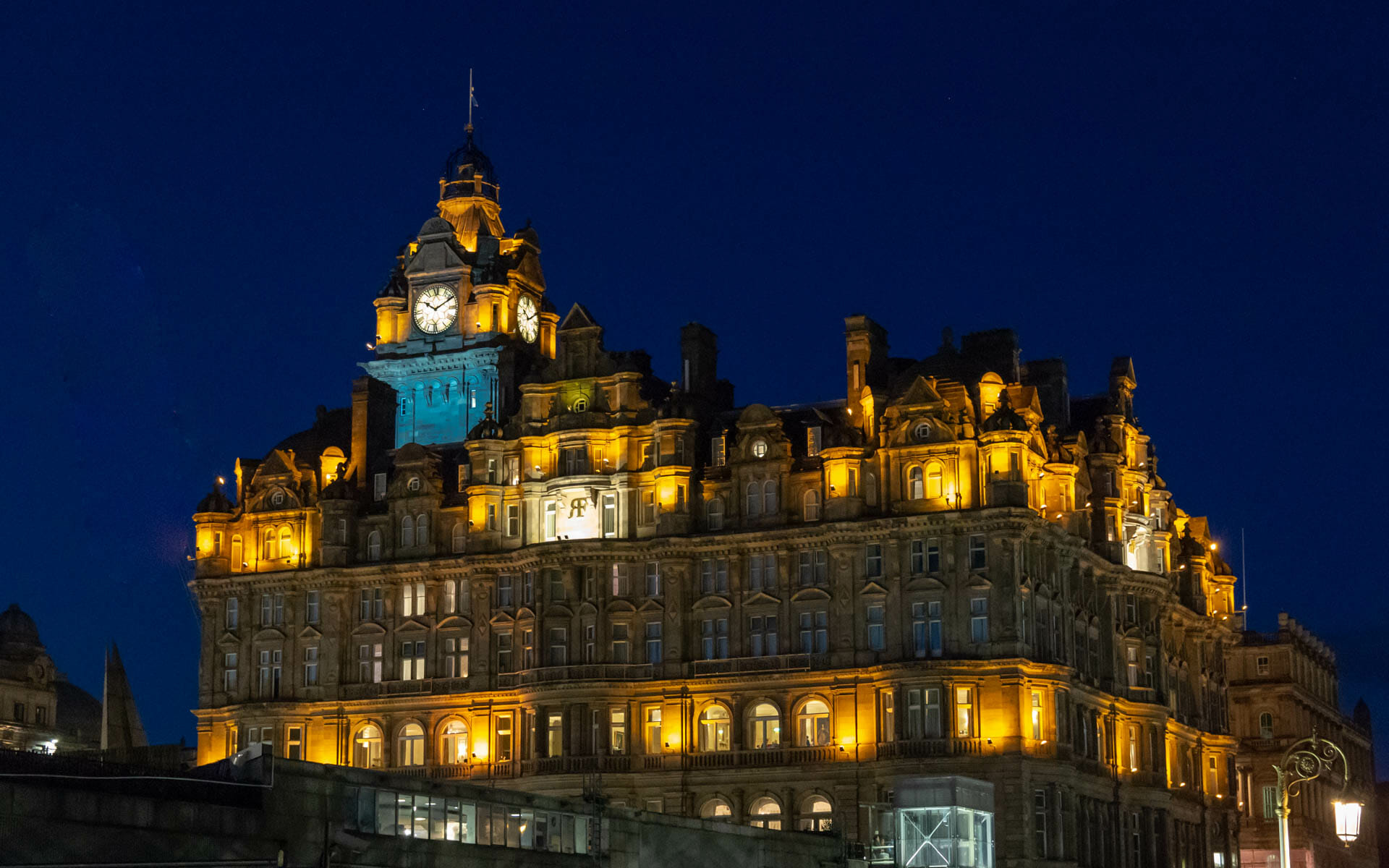
The Balmoral Hotel on Princes Street next to Waverley Station is a real gem. It dates back to 1902 and has hosted many world-famous guests. J.K. Rowling wrote the final instalment of the Harry Potter series in a suite now named after her.
Balmoral is beautifully illuminated at night. The only thing you shouldn’t rely on is the beautiful tower clock: it is always three minutes fast so that passengers can reach the train safely. The clock only shows the correct time on New Year’s Eve.
Opening hours:
always accessible
Admission: –
Address: 1 Princes St, Edinburgh EH2 2EQ
Periphery: Old houses and harbours
Dean Village on the River Leith
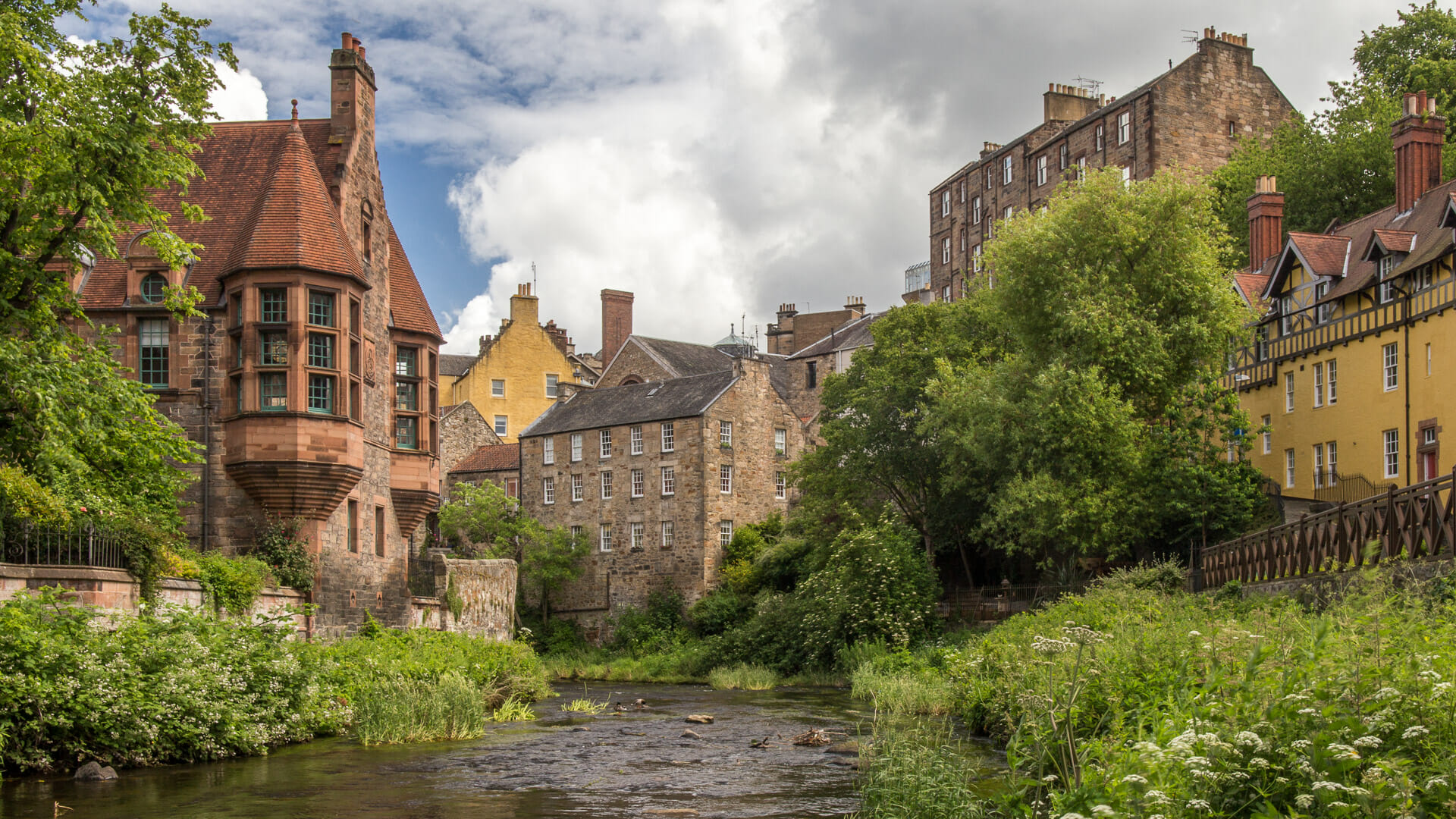
Dean Village was an independent community until the 19th century. Today, however, it is a part of Edinburgh that lies to the north-west of the city centre. The Waters of Leith Path runs along here. You can walk along the river past the old houses of Dean via a cemetery to the Scottish National Galleries of Modern Art and back again.
A detailed photo report and the tour information for the path can be found here.
Opening hours:
always accessible
Admission: –
Address: Dean Path, Edinburgh EH4 3AY
Scottish National Gallery of Modern Art
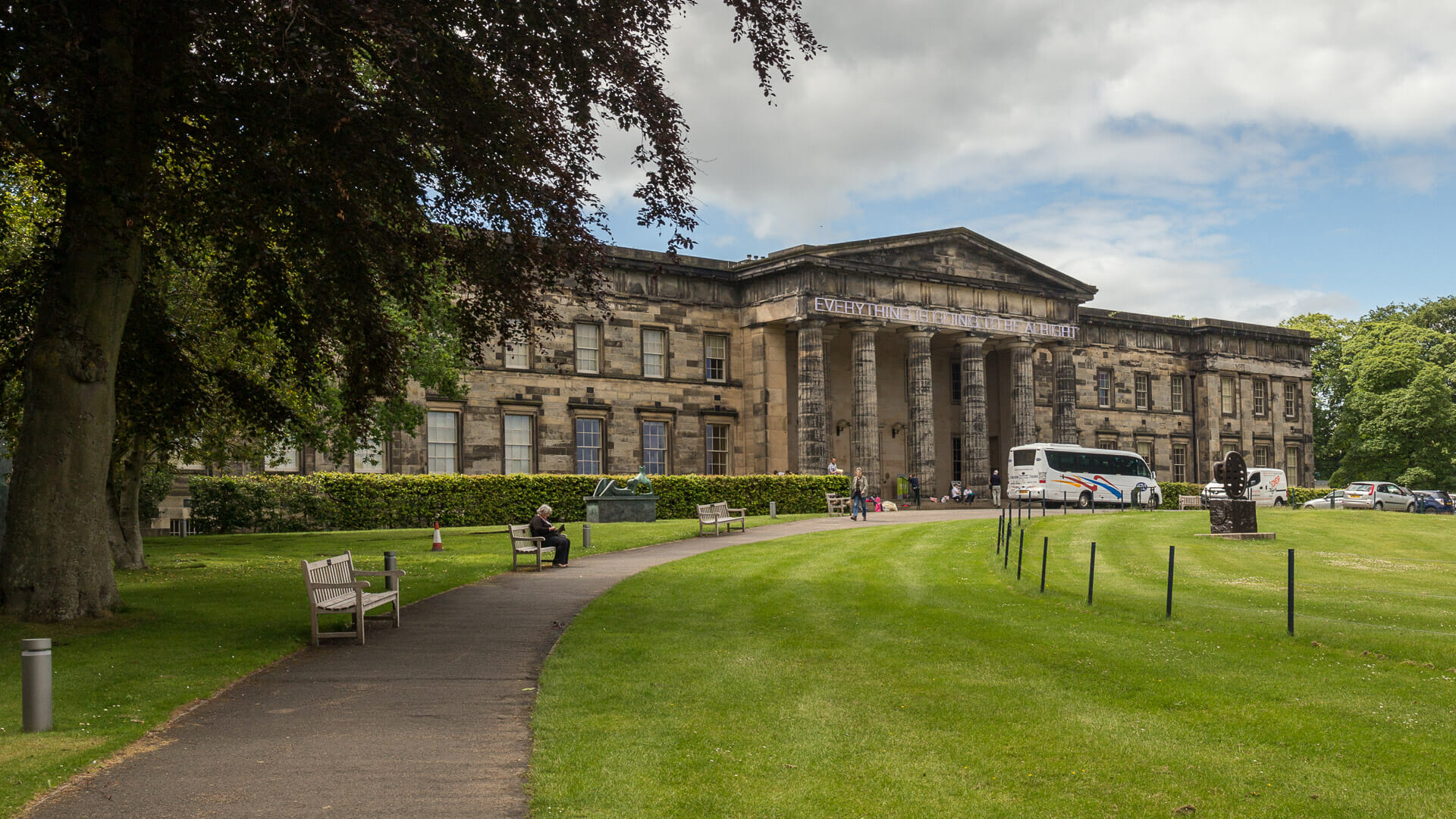
While the Scottish National Gallery still has the classics in its repertoire, the Gallery of Modern Art shows paintings and sculptures from more recent history. These include Picasso, Matisse, Warhol and many more.
As with most state museums, admission is free. However, admission fees may apply for some special exhibitions. The buildings are located just outside the city centre, around 15 minutes’ walk from Princes Street.
Incidentally, this can be combined with a walk through Dean Village.
Opening times:
daily 10:00-17:00
Admission: free
Address: 75 Belford Road, Edinburgh, EH4 3DR
Web: www.nationalgalleries.org
Royal Botanic Garden Edinburgh
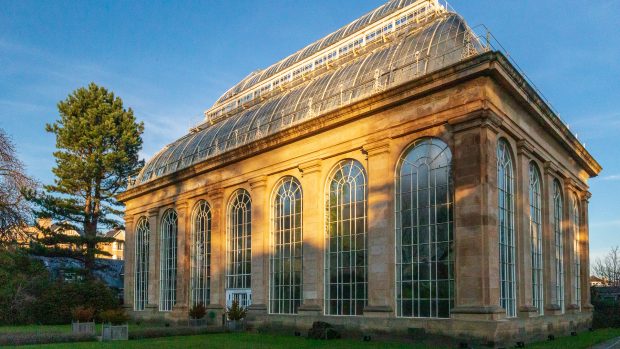
Inverleith is home to the splendour of 100,000 plant species. Some of them are protected in greenhouses, such as the Victorian Palm House. One star of the botanical gardens is the titan’s root and the devil’s tongue, which even has its own Twitter profile.
Read more about the Royal Botanic Garden Edinburgh in this article.
Opening hours:
daily 10:00-17:00 (summer), closed up to two hours earlier in winter
Admission: Gardens free, glasshouses currently closed for renovation
Address: Arboretum Pl, Edinburgh EH3 5NY
Web: www.rbge.org.uk
Leith: Edinburgh’s harbour
At the mouth of the River Leith lies the village of the same name, which is now a district of Edinburgh. It has always been important for the capital, as Leith was and still is Edinburgh’s harbour. So important, in fact, that the once independent town was incorporated against the wishes of its inhabitants. Today, the tranquil promenade shore is lined with restaurants and pubs that now charge upmarket prices.
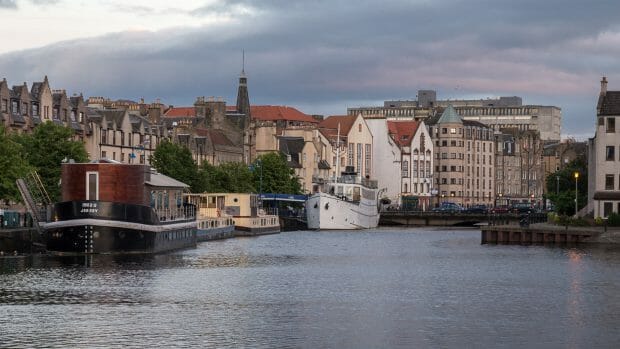
Further out to sea, however, Leith is still a functional harbour with docks where large ships are moored.

And another ship lies in the harbour of Leith …
Portobello Beach: Edinburgh’s beach
Leith is Edinburgh’s gateway to the sea, while Portobello is Edinburgh’s beach. And what a beach it is! It stretches for kilometres along the old seaside resort, which is only around six kilometres from the city centre. It can easily be reached by bus in half an hour.
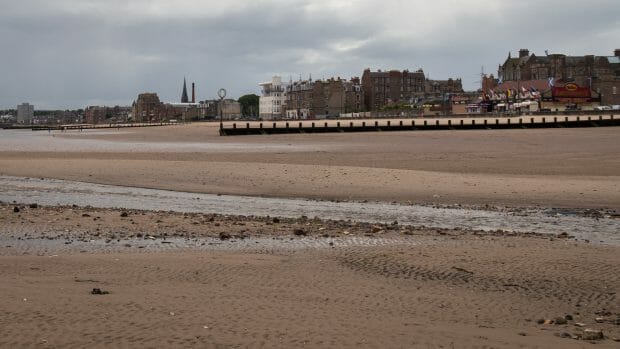
Shopping in Edinburgh: Some tips for shopping
On the Royal Mile there are more tourist-orientated shops that offer many souvenirs or “typically Scottish” items – shortbread, Harris Tweeds, kilts, etc. But be careful: it’s worth comparing. We were offered the same handbag for completely different amounts all over the Mile.
There is a real highlight right at the beginning of the Royal Mile near the Castle: the Tartan Weaving Mill and Experience initially looks like a small shop when you enter. However, after walking through it, the following shopping centre is revealed:
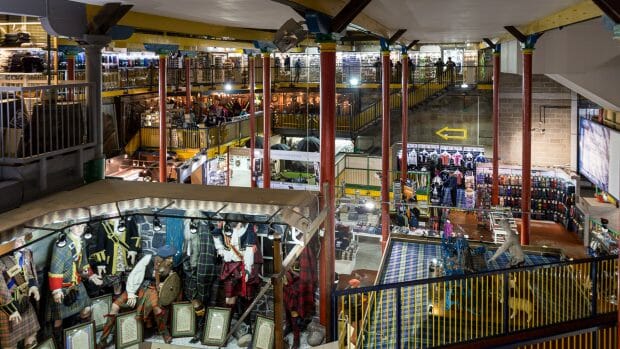
Around The Hub, a staircase leads southwards down to Victoria Street. This street leads down to the Grassmarket and here you will find small antique shops, clothing boutiques and whisky shops behind colourful facades. Strolling here is fun in itself.
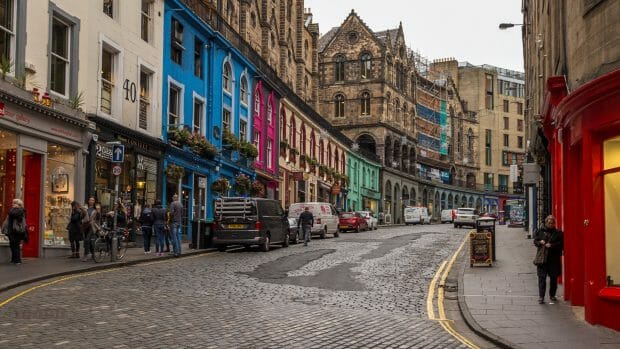
Back down the Royal Mile, a little way after John Knox House and before the Tolbooth, you will find Fudge House. If you like the typical British sweet fudge, you will find new flavour variations here, such as “rum and sultana”, “pecan nut”, “triple chocolate” or “spicy ginger”.
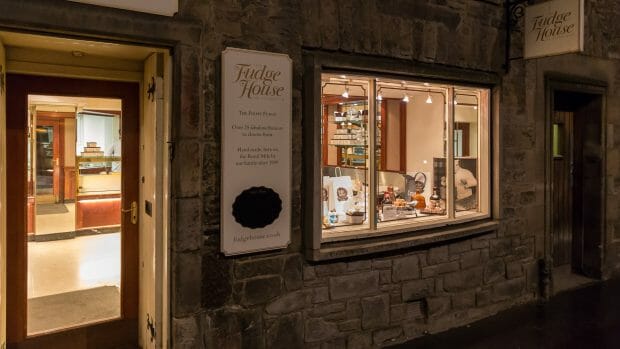
Diagonally opposite the Fudge House is Cadenheads, the oldest independent bottler of whisky in Scotland. There are usually three to four barrels of a fine variety open here, which are then bottled in the desired bottle sizes for the customer. However, you don’t buy brands such as Talisker or Caol Ila here, but regions. The producers are usually not named. Some find the shop untidy and dirty, others find it extremely cosy (I belong to the latter group and have bought some very tasty bottles there).
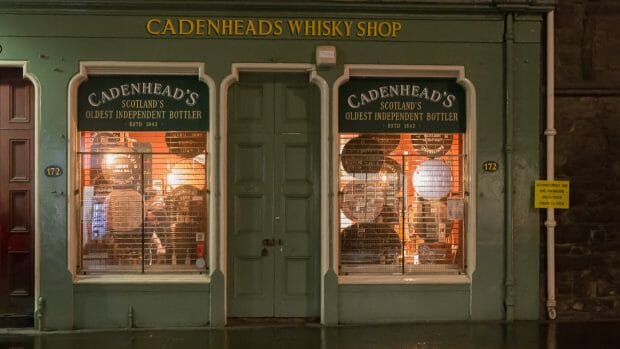
While the Royal Mile has a historic feel, visitors to Edinburgh will find many modern clothing shops in the New Town, starting at Princes Street Gardens.
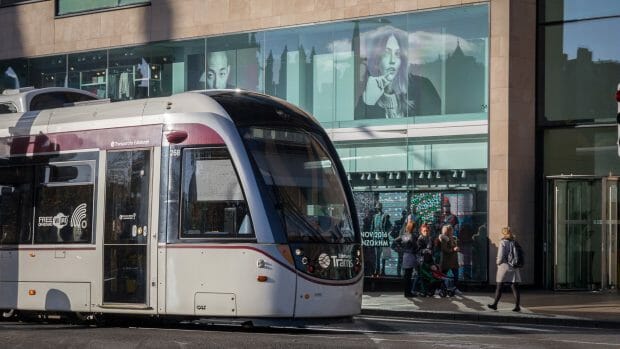
Princes Street and George Street are home to a number of clothing shops.
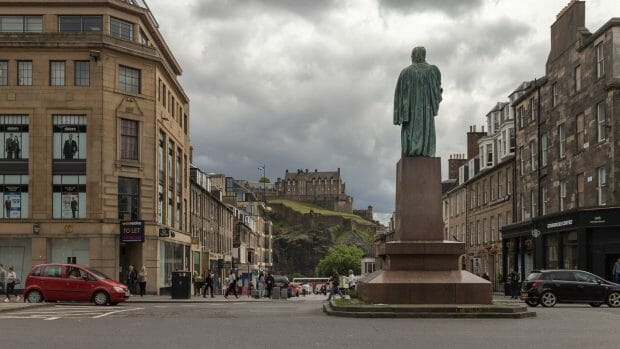
A small alleyway, Rose Street, runs parallel between the two large streets. Pubs and restaurants are lined up here.
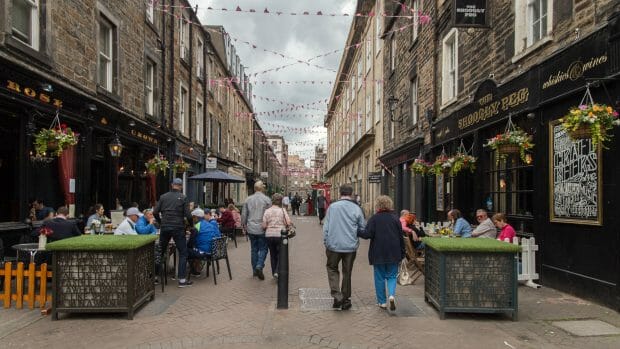
Extra tip: There are many small antique shops in Edinburgh. I report on our experiences here.
Festivals: Theatre culture and street art dominate in summer
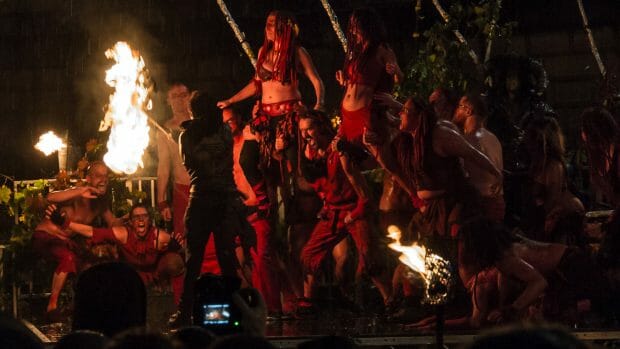
Edinburgh is packed in August. No wonder, because this is when Scotland’s capital becomes a festival city: 25,000 artists come to the city and present themselves at more than 1,000 shows. The festivals run almost simultaneously during the summer:
- The Royal Edinburgh Military Tattoo in the square in front of Edinburgh Castle
- Edinburgh International Festival at The Hub
- Festival Fringe all over the city
- Edinburgh International Book Festival in Charlotte Square Gardens
The Fringe Festival is, after all, the largest cultural festival in the world. At this time of year, the streets of the city centre are firmly in the hands of many street performers, around whom clusters of onlookers form. There are also theatres and stages where art and comedy are shown for a fee.
The International Festival in the Hub, on the other hand, focuses entirely on classical disciplines such as theatre, musicals, ballet and opera.
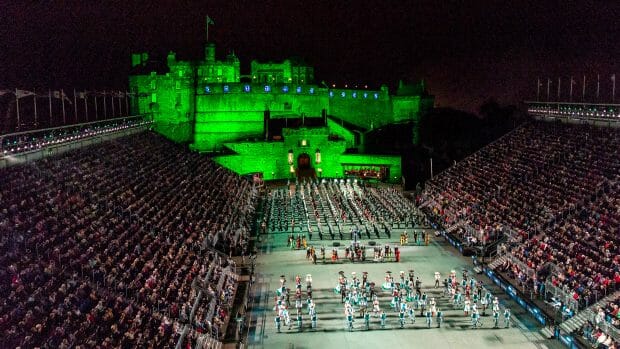
The Royal Edinburgh Military Tattoo features bagpipe bands, military groups and dancers, mainly from Scotland, but always with international guests. Every year, the Tattoo attracts over 220,000 people to the Scottish capital. Tickets are coveted and expensive. Tickets start at 25 pounds with poor visibility and go up to 300 pounds in the Royal Gallery. You can find a report on the Tattoo here.
And the Edinburgh International Book Festival brings readers and authors together around the theme of books.
Two related parades take place in Edinburgh on 30 April and 31 October: Beltane welcomes spring, Samhuinn marks the coming of winter. On both occasions, painted carnies parade through the city with lots of fire until they reach a stage where the final spectacle takes place. An experience report with many pictures of Samhuinn (Halloween) can be found here.
The Christmas market in Edinburgh begins in mid-November and lasts until 5 January. There is a Ferris wheel, other rides for children and of course stalls with food, drink and bric-a-brac.
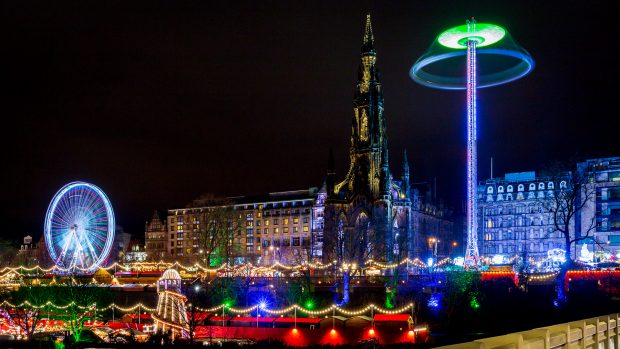
Finally, the Scottish New Year’s Eve festival, or Hogmanay to be more precise, is an experience all of its own, when torchlight processions, live stages and ceilidh dances send the city into a New Year’s frenzy over three days from 30 December to 1 January.
There are many other festivals that focus on science, visual arts, blues & jazz and much more. A complete overview can be found here.
Climate & weather: The best time to visit
Edinburgh is located on the east coast of Scotland, the neighbouring sea is the North Sea. The advantage: the rain usually comes from the west – by the time you reach Edinburgh, the clouds have mostly cleared. This is one reason why Glasgow has to endure twice as much rainfall per year as Edinburgh.
The best time to visit Edinburgh is, of course, summer. However, it’s important to remember that August is when all the festivals take place, the city is very busy and the hotels are fully booked.
In terms of travelling time, May offers an interesting alternative: little rainfall, lots of sunshine and not so many tourists. As the sun sets quite late in May, visitors also have plenty of time to see Edinburgh’s sights at their leisure – of course only those that are not open.
Here is the climate chart for Edinburgh:
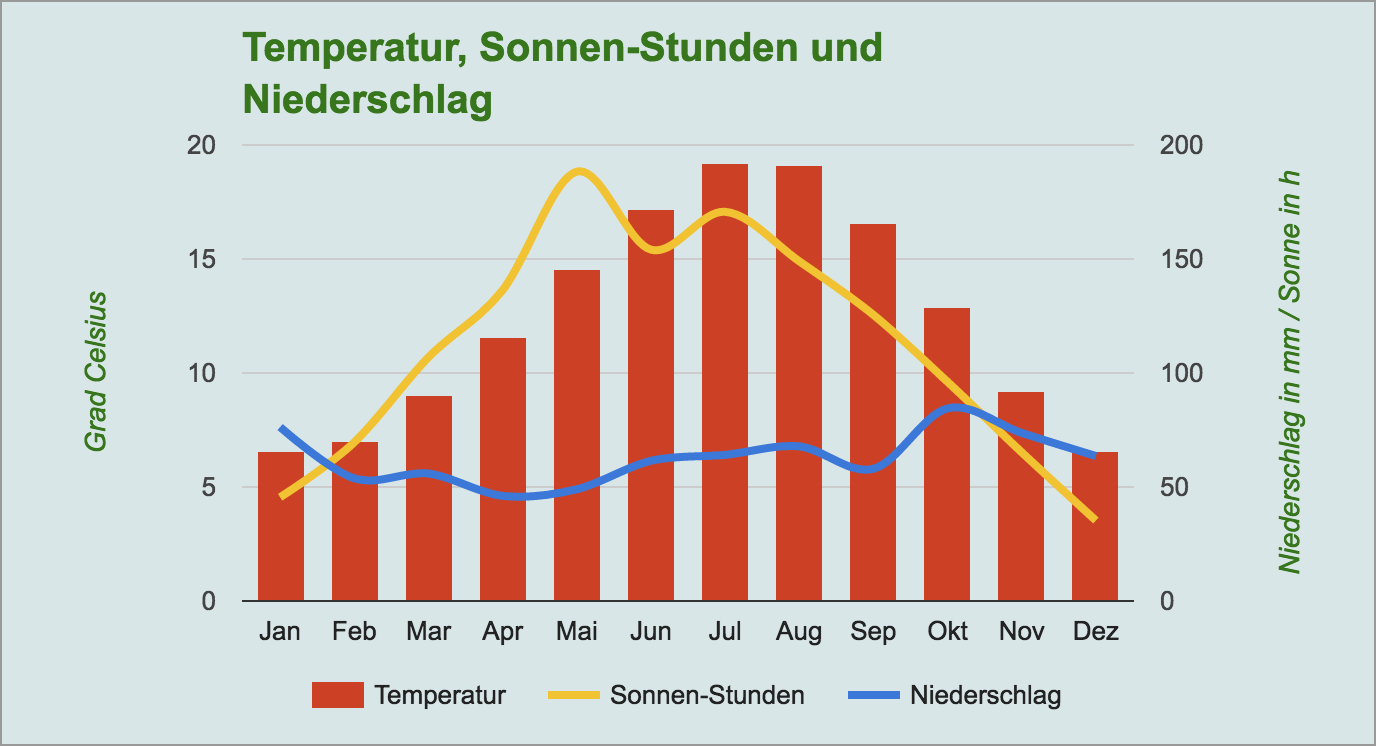
Note: A climate diagram summarises measured values from previous years and only says something about the probability. I’ve already had a rainy June and a glorious November. There’s so much to see and do in Edinburgh, even when it’s raining or cold.
Accommodation in Edinburgh
I have already stayed here
Motel One Edinburgh-Princes
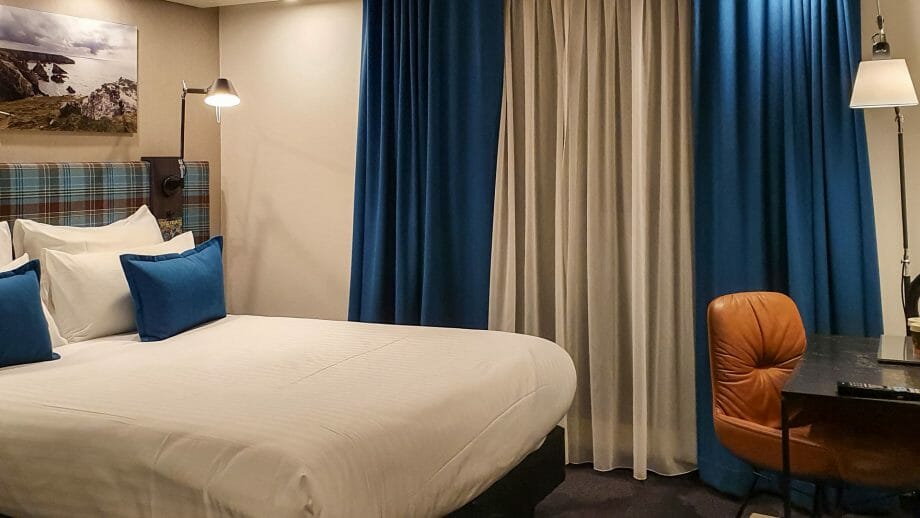
The city’s one Motel One is located directly on Princes Street. It is a little more expensive, but still in the middle of the price spectrum. One difference to the other Motel One is the large breakfast room.
Click here for the Motel One Edinburgh Princes (advert)
Motel One Edinburgh-Royal
Even more central and slightly cheaper than the one on Princes Street. Breakfast is served a little closer together. Otherwise the standard is the same. The Royal Mile is just up the stairs at the hotel. Our favourite.
Click here for the Motel One Edinburgh-Royal (advert)
What others like to book
Summer Stays at The University of Edinburgh
The “Summer Stays at The University of Edinburgh” are popular and in the mid-price segment. They are located on the university’s modern campus at the foot of Arthur’s Seat, just south of the city centre. During the university’s summer break in June, the flats are transformed into a bed & breakfast.
Click here for the Summer Stays at The University of Edinburgh (advert)
Kick Ass Greyfriars & Grassmarket
A budget accommodation right in the centre of Edinburgh, located at the famous Greyfriar’s Bobby cemetery. Also good for people who are travelling alone and want to socialise.
Click here to go to Kick Ass Greyfriars (advert)
Just round the corner, another offshoot welcomes guests.
Click here for the Kick Ass Grassmarket (advert)
More accommodation at Booking.com
A list of accommodation in Edinburgh can be found on the Booking.com website.(Link and map widget are adverts)
You are currently seeing a placeholder content of Booking.com. To access the actual content, click on the button below. Please note that data will be passed on to third-party providers.
More informationPublic transport: Tram, bus & train – travelling in Edinburgh
While Glasgow is the only city with an underground railway, Edinburgh has been countering this for several years with a tram – the Edinburgh Tram. Among other things, it connects the airport with the city centre. It is also modern: it offers its passengers free Wi-Fi on the journey
How to get from Edinburgh Airport to the city centre:
Edinburgh Airport is around 10 kilometres from the city centre. The Edinburgh Tram runs directly from the airport to the city centre. The journey takes around 35 minutes from the airport to Princes Street in the city centre. It runs approximately every seven minutes and costs £7.50 one way and £9.50 return. Children £3.80 and £5 (as of 2023).
Alternatively, the Airlink 100 from Lothian Busses operates. It takes around half an hour from the airport (bus stop area D) to St Andrew Square directly into the city centre. It runs every ten minutes and costs £5.50 one way and £8 return (as of 2023).
You can buy tickets for the Airlink bus to and from the airport online from Getyourguide. Just click here (advert).
How to reach destinations in Edinburgh
Princes Street and Waverley Bridge are also used by a large number of buses that take you to all corners of the city. The main bus operators are Lothians Busses, Service 13 and EMH.
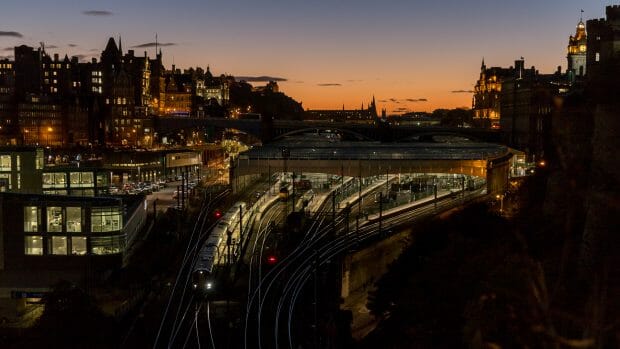
Waverley Station, which is also located in the centre of the city, is the hub for rail connections and from here trains run partly underground under the nearby Princes Street Gardens. Glasgow can be reached from here by train in around an hour. From there, travellers can reach the West Highlands, for example via the wonderful West Highland Railway Route, which runs through Rannoch Moor to Ft William and Mallaig.
There are direct connections from Waverley to Fife and up the east coast via Inverness to Thurso. There are also many lines connecting the city with the suburbs from here.
Edinburgh Bus Station in Elder Street near St Andrews Square, a few minutes’ walk from Waverley Station, also serves as a hub for the Citylink buses, which travel to all corners of Scotland.
While the hop on – hop off sightseeing buses in Glasgow are ideal for taking in the sights, they are only suitable to a limited extent in Edinburgh. They are not allowed as far as the Castle or St Giles Cathedral, as these areas are traffic-calmed. However, some providers make up for this by travelling as far as Leith or South Queensferry. This page gives an overview of several providers.
You can buy tickets for the 24-hour hop-on hop-off bus from Citysightseeing online from Getyourguide. Simply click here (advert).
By the way: The taxis in the city are reasonably affordable and therefore a cosy alternative for more than one person.
General information about Edinburgh
Geography: Where is Edinburgh located?
Edinburgh is located in the south-east of Scotland in the Lothian region. Lothian runs below the large North Sea bay of the Firth of Forth, to which Edinburgh also has a harbour in the district of Leith.
People: Scotland’s capital, but not the largest city
According to the 2022 census, 514,543 people live in Edinburgh, which is slightly less than a tenth of all Scots and around 105,000 fewer than in Scotland’s largest city, Glasgow. However, Edinburgh is Scotland’s capital and the seat of the Scottish Parliament, which largely exercises its own powers in the UK.
Crime: a safe city
As recently as 2015, various newspapers reported that the area in and around Edinburgh had the highest crime rate in Scotland – higher than Glasgow, which used to be regarded as the murder capital of the UK. As a result, the crime rate fell steadily thanks to courageous police work. In terms of the number of offences per 10,000 inhabitants, Edinburgh is now behind Dundee and Glasgow.
In short, you can feel quite safe in Scotland’s capital as long as you bear in mind that big cities always pose a certain risk to tourists all over the world – for example from pickpockets.
Scots: Dialect in Edinburgh
For the most part, English is quite clear in the city centre, but in some areas you can also hear a distinct variant of Scots. Edinburgh” quickly becomes “Embra”, if you are drunk, it is referred to as “reeking” or you are asked to look at something with “deek”.